












































































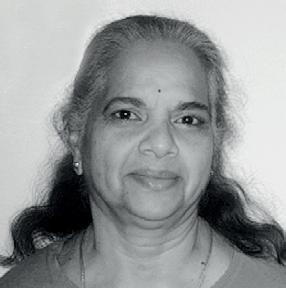
























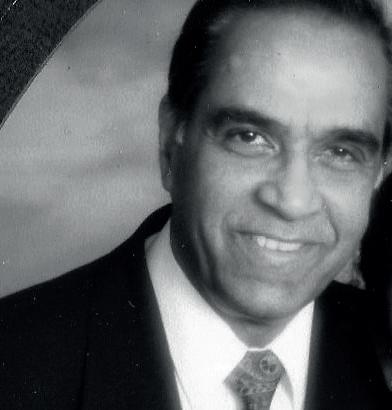





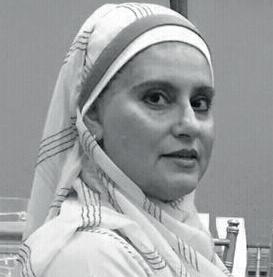



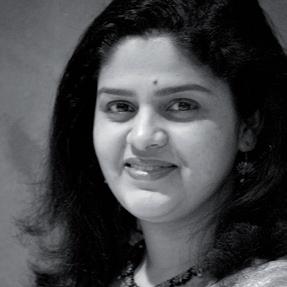
































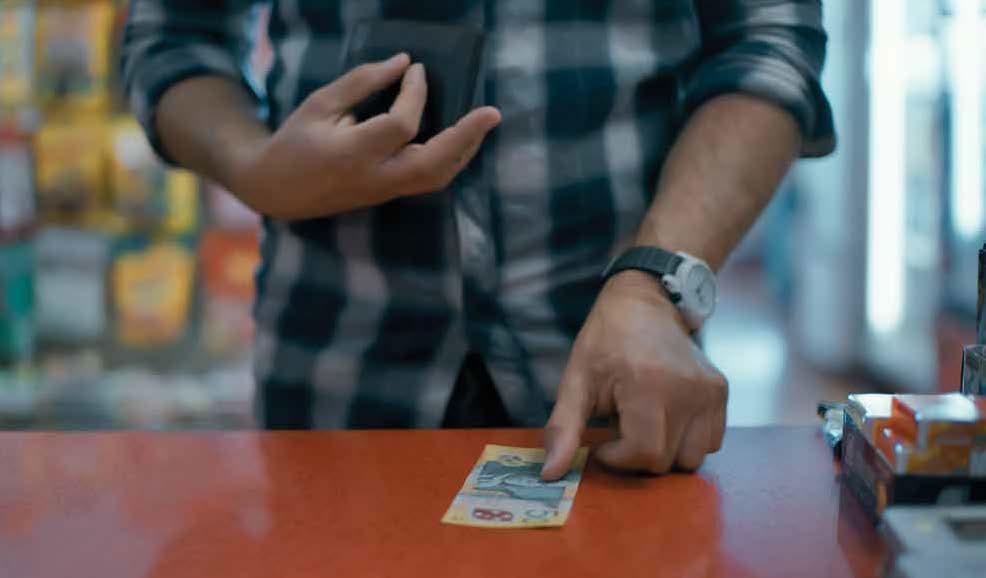




PUBLISHER
Pawan Luthra
EDITOR
Rajni Anand Luthra
SOCIAL MEDIA
Suruchi Sehgal
MELBOURNE COORDINATOR
Preeti Jabbal
CONTRIBUTORS
L
HEAD, SALES AND MARKETING
Vivek Singh

SALES OPERATIONS
Charuta Joshi
Indian Link is a fortnightly newspaper published in English. No material, including advertisements designed by Indian Link, may be reproduced in part or in whole without the written consent of the editor. Opinions carried in Indian Link are those of the writers and not necessarily endorsed by Indian Link. All correspondence should be addressed to:
INDIAN LINK MEDIA GROUP
Level 24/44 Market St, Sydney 2000

GPO Box 108, Sydney 2001
Ph: 02 9279-2004
Fax: 02 9279-2005
Email: info@indianlink.com.au
 BY PAWAN LUTHRA
BY PAWAN LUTHRA
What a start to the year - no, the decade - it has been.
Having endured the bushfires of January and the rains of February here at home in Australia, this month we join the rest of the world as we stare at an unprecedented health emergency.
The global pandemic that is the novel coronavirus (COVID-19) has all but shut 2020 down.
The severity of the situation has hit home now that the voice of the medical fraternity has finally broken through the rhetoric.
There’s been an overload of information assaulting us from all sides – social media in particular –that we’ve had to sift through to get to the facts.
New words have entered our lexicon: social distancing, selfquarantine, herd immunity; and phrases like ‘flattening the curve’ are used umpteen times as part of our everyday conversation. (The word ‘corona’ itself, we’ve come to
learn, means crown; it’s easy to see from the images of the virus how the nomenclature came about).
Grappling to make sense of it all, if we as adults have had to decipher an entirely new reality, wonder how the young ones are taking it.
Give a thought to the youngsters around us, especially those between 10-14, as they react to this information overload.
Going through their own natural developmental crises to whatever level, their world has changed, albeit temporarily, as they look at schools closing down, lessons online, public outings banned, music festivals cancelled, talk shows filmed in empty auditoriums, paranoid parents enforcing hygiene rules with stronger than usual strictness, and shock horror, toilet paper shortage. They read reports about 250,000 potential deaths in the UK and over a million in the US if the pandemic is not managed correctly, and the proposition that the old and frail could go without treatment in favour of younger people.
To top it all, they’re probably met with no magic words as they seek reassurance from significant adults.
You’ve no doubt had these discussions in your own family by
now. And science, you might have observed, has probably helped ease the conversation, as you explained what a pandemic is; how its spread takes the shape of a curve; what from experience has helped flatten that curve; what we can do at an individual level to protect ourselves, our family and the wider society; how we await the development of a vaccine; how mankind has always found the answer with other epidemics, and how loo paper hoarding actually does more harm than good.
A great opportunity no doubt to inculcate that scientific temperament. And the lesson to trust and believe that like all waves, this too shall pass.
If you’re working from home, model disciplined work routines and show off those checked to-do lists.


And remember to keep in touch with significant others via phone or online.
The penny had dropped with last year’s drought and this year’s calamitous bushfires, that with the environment, we are in dire need of new paradigms of thought and functioning. With COVID-19, perhaps the same is true in terms of public health.
Looks as though 2020 will go down as a reset year in many walks of life.













The Prime Minister of Australia sent out his Holi greetings nice and early in a video message and as a special release.

Scott Morrison wrote: Namastey. I am delighted to wish everyone celebrating the Festival of Colours, a happy Holi!
Holi is a time to welcome the arrival of a new season, exchange gifts and enjoy traditional music and dancing. It is a time to be with family and friends. Many also mark this special moment with the throwing of gulal, a joyful custom that has been embraced around the world. The Festival of Colours is a wonderful opportunity for the broader community to embrace another culture and enhance their understanding of multicultural Australia. Australia is a country built on the riches of many traditions, and every faith and every community group is an indelible part of who we are. Each of us enjoys the freedom to go about our lives, to realise our aspirations and be acknowledged for our efforts regardless of creed, race or culture. This is the promise of Australia and this is the ideal that sits at the heart of how we live as citizens, and how as a nation we remain resilient and strong. I thank everyone celebrating Holi for your commitment to these values and to the peaceful future of our country. I hope everyone celebrating Holi has a wonderful festival, and a year lled with love, joy, peace and prosperity.
Dipen Patel wrote: Scott Morrison, without water how can we enjoy Holi?? Lockyer Valley has run out of water. I am currently saving water. If you want us to celebrate Holi then please arrange water for our community.

Shweta Sharma wrote: Scotty, very proud of you - you pronounced the word ‘namaste’ correctly.
Vandana Suri Mehra wrote: Happy Holi to you too! Thanks for the lovely message to us.
Usha Madhavan wrote: Thank you, Prime Minister!
Paviter Kumar Noori wrote: A bit strange that the Prime Minister signs the letter in future date. Isn’t Holi on 9 March? Happy Holi though!
Aribam Premi wrote: Happy Holi.
Vivek Singh wrote: What's the source of this letter? Has ScoMo shared this on his social media handles?
Indian Link replied: Vivek Singh, the PMO often sends press releases and best wishes from the PM on Indian celebrations.






Should the Australian Government. declare a lockdown?
84% Yes. That will help contain the epidemic. 16% No, it’s not an emergency in Australia yet.
Scientist, academic, Indian Link contributor and Isaac Newton fan Dr. Sydney Srinivas had an interesting experience on a recent UK trip. I visited Woolsthorpe Manor recently, the birthplace of Isaac Newton, which is now a museum. I presented to the museum copies of my book Isaac Newton (Prism Books, 2017). A great experience for me noting that it was here that Newton had his Annus Mirabilis circa 1666. In those two years he discovered gravity, did his experiments on light, and invented Calculus. He was only 26. It does not end there. As soon as a staff member heard that I have also written a book on Newton in my native tongue Kannada, he led me to an exhibit inside the museum. What did I nd there? My own book on the great man, Sir Isaac Newton (Vasantha Prakashana, 2014). Nothing can make a writer happier.


We asked you to identify this unusual natural wonder.
This one troubled you a fair bit: no correct answer was received, although entries came in such as Sinhagad Fort and Lohgad Fort in Maharashtra. The correct answer is Naneghat, in the Western Ghats of Maharashtra (so at least you got the general vicinity right!) The waterfalls here are a rare natural phenomenon because of the high winds – the updrafts force the water to blow back upstream, resulting in a sort of reverse waterfall.
My trip to India has rekindled my love of Poori, an Indian deep-fried atbread. I have posted a Banana Poori recipe from my book ‘Kitchen Garden Companion: Cooking’ on my website. Let me know what you think.
Stephanie Alexander, Australian food writer

India with a billion people has a third of the cases that Canada does with 37 million. India has been doing this a lot longer than everyone else. Yoga and Ayurveda, are great tools to prevent illness. We should all be working together.
Patrick Brauckmann, Canadian Indophile
You liked our story on Sant Nirankari Mission Australia’s donation of nearly $20,000 for Blacktown City Council Bush re Appeal.

Raj Saqi wrote: Our Sydney-based community has such wonderful caring people.
Adarsh Kumar wrote: Fantastic way of celebrating Lord Hardev's birthday. A tting tribute indeed. Well done, Team Sydney. May Nirankar bless.
Dev Singh wrote: Service of humanity is practical divinity.
Great achievement SNM Sydney, Nirankar bless all.
Sanjeev Sailani wrote: Say with love, Dhan Nirankarji.
Vik Bhandari wrote: Fantastic achievement.
Sanjeev Sailani wrote: Lots of love from India.
We asked you to identify this magical holiday attraction.

What’s Shilpa Shetty thinking as she eats her makhan malai breakfast?

Arix Bishnoi wrote: Only posing, not eating. #BuyMyFitnessProgram
Raj Saneja wrote: My mother-in-law sent it with love. I don’t have the heart to throw it away.
Vandana D'souza wrote: The breakfast “show”



Anurag Singh wrote: Wonder how much yoga I’d have to do today after eating this for the camera.
Arix Bishnoi wrote: I wish I could eat all of this. Just a tiny bite won’t hurt.... hack with dieting, I’m eating it all!
Neetasha Sharma wrote: No retakes please!
Suruchi Sehgal wrote: A pot full of makhan malai, Haven't tasted I won’t lie. Cuz once on the lips, forever on the hips!
Preeti Kothari wrote: Hey Bhagwan (gulp) kitna squat karna parega (raises eyebrows) koi baat nahin, karloongi....
The single correct answer came from reader Hardik Gajjar who identi ed it as Fairy Park in Anakie, Geelong Victoria, the oldest theme park in Australia.
Tomorrow I will be making my rst gulab jamun, very excited for that. If you have tips let me know.
Chrissy Teigen, US showbiz personality



it
My colleagues at @JohnsHopkins have informed me that #CowUrine does not ward off the #Coronavirus. If anything, it is a recipe for even more ailments. #India needs science as a guide.
Prof. Steve Hanke, American
applied economist




Bene ts of cold water immersion in the Holy Ganges are both physical and spiritual.
Jonty Rhodes, former South African cricketer

Are visas not being issued? Can an OCI holder be left stranded in India?
Nandakumaran Konnat of the Consulate General of India (Sydney) sits down with PAWAN LUTHRA to offer clarifications
There are no visas being issued for people wanting to travel to India. How long is this restriction in place?
That’s not true. Visas are being issued to people who want to travel to India. The aim is to restrict it. We’re not sure if we’re at the threshold of controlling (coronavirus cases), so it’s best that we restrict travel. In case of emergencies and compelling reasons, we are issuing visas.
For Indian passport holders, there are absolutely no restrictions on travelling back to India.
So if you have an Indian passport, you can get onto the next flight to India. But do OCI holders need a visa?
Valid visas, whether it’s a sticker visa or any other visa issued prior to these restrictions, are all held in obeyance. This travel restriction is till the 15th of April. Until it is revised, individuals will need to apply for a visa and get a fresh one issued. And it will be issued based on their compelling reason.
Anybody can come to the VFS office, fill up a manual form, provide documents that prove there is an essential reason to travel, and we’ll take a clearance and issue it.
How long will it take between filling the form and being issued a visa? That depends. We have issued some emergency visas in 24 hours.
If there’s a wedding in the family in India and someone wishes to travel, would that constitute a special clearance visa? You can’t completely define ‘compelling reason’, but some are: family emergencies, death of a family member, unavoidable business meetings, marriages (keeping it
restricted within blood relatives and the bride and groom’s families), major sporting events, and minors holding foreign passport of parents with Indian passports.

For parents holding an Indian passport with dependents like children who are OCI holders, there’s an ability for the child to get special clearance to travel with them in case it’s an emergency or a special requirement – is that correct? That’s correct. If the parents want to go, it’s taken that the children travelling along have a compelling reason, and the visa will be issued.

Do you need any special visas in case you’re travelling to Dubai or London transiting through, say, Delhi? Do you need special clearance, or can you board the plane?
Transiting through India if you’re not leaving the airport is not a problem. If you are transiting through another location and reaching India, you should be prepared for a medical screening.

If you spend time in, say, Singapore, for a four-hour layover and you’ve been outside, there is a reason for you to be medically screened when you get out of the airport.
That is if you have a visa to stay in India and not transiting through India?
Yes, it applies if your final destination is India.
What has been the experience in case someone has an Indian passport and they test positive once they arrive in India? They will be taken to a medical facility for further treatment and analysis. If you’ve travelled through destinations and haven’t
tested positive, you are supposed to selfquarantine. I request anyone who travels to keep updated on advisories issued on the Bureau of Immigration website.
Things are changing quite rapidly… Yes, it’s very dynamic. The advisories issued are till 15th April. A lot of people ask what will happen after that, but it’s hard to predict. Everyone has to remain updated on the situation. The Consulate is more than willing to handle queries and questions within our reach.
If an OCI holder or someone with a special visa is visiting India and there’s a lockdown on people coming back, what happens if the visa expires? Can they get it extended? Every district in India has a Foreigners Regional Registration Office (FRRO) that is meant for this reason. Contact them to request for an extension. They may ask for some documents, and as long as you provide the correct documentation,the visa will be extended.
Anything else you want to add?
Earlier today, Prime Minister Modi said that we should prepare, but not panic. If you can avoid travel, avoid it. At the Consulate we get a lot of anxious queries…
Know that we aren’t stopping anyone from going. If there’s a genuine reason you should go, we’ll allow it.
Australia should be alert but not alarmed, that seems to be mantra of the day!

Closely on the heels of the Prime Minister’s announcement that restrictions are in place for outdoor gatherings of 500 people, comes a similar announcement that indoor gatherings of more than 100 people will now not be permitted. The restaurant industry is already reeling under these new regulations in response to the coronavirus outbreak. While restaurants owners in the community understand the urgency of such a step, some feel they might not be able to bounce back once the spread is stemmed.
CHARUTA JOSHI spoke with restaurateurs on Indian Link Radio to see the strategies they are putting in place to adapt.

I’ve seen a drastic drop in business. Everyone is afraid to go out in public, and restaurants can be a prime place of infection because of the close interaction. We are not surprised to see this downturn at work.
The panic buying has de nitely affected us. I typically keep a month’s stock in the restaurant but in the last two weeks, with business seeing a downward trend, my problem is what do I buy! Prices have gone sky high. The fresh produce I buy for $300 - $400 is now costing me $800. Paper towels which I cannot do without in the restaurant, cost me $14$15; I’ve just paid $60. There’s also a drastic jump in meat prices whereas business has rapidly gone down.
What are my options? Well, we’ll wait and watch - for another week maybe. If we nd we are unable to survive, we will just have to close down.
I have ten full-time staff, and they’re all concerned. I’ve assured them they’ll still be able to pay their rents, and as for food, they’ve been told they can cook at work for themselves, there is enough grocery for now. There’s not much else I can do!
As regards clients, some regulars who’ve been dropping in for the last 2 – 2 ½ years are still coming and we are thankful.
Let’s hope the situation gets better soon. I believe the experts: it will come under control when the border is closed and there is a complete lockdown. I do think people should stay home for a while. And if someone is unwell, they should be immediately taken to the hospital. It’s hard for me to advocate for a lockdown, because I’ll be losing $20K - $30K a week, but saving human lives is more important.




I’m seeing lots of sanitisers on our tables! Especially people with kids. The general directive these past few days has been to avoid going out to places where there could be crowds or gatherings, so it is de nitely affecting the hospitality business.
People are preferring to stay home and eat home cooked meals.
It’s a very tough time. But people are aware that the virus doesn’t spread through food, so I’m sure it will pick up, particularly in home delivery. Our restaurant is completely ready. We have tie-ups with all home delivery companies.
For the moment though we are concentrating on cleanliness. The government is trying to do their best to safeguard all of us no doubt, but we also believe the experts who say the condition could get worse, till we do not get a vaccine for this.

Everyone’s in the mood currently to look after their daily necessities so going out to eat is not such a priority. But I’m seeing a mixed pattern in the restaurant business. I can say Harris Park area is very badly affected. In the current scenario, diners are preferring to eat vegetarian food, so the veg business is not affected as much. At this stage I would say, business is surviving; can’t comment on the future!
Besides the visible drop in dine-in numbers, I’m also seeing people highly conscious of hygiene, sanitising etc. It can be a challenge to win customers in these circumstances, but if you do the right thing I think any business can survive.
Home delivery services can be an option now. We’ve outsourced our home delivery services since Day One, and I can now see a jump there because people are beginning to avoid gatherings.
Regarding green grocery the local produce continues to be the same for now at least, but Australia completely relies on some Asian countries for some fresh vegetables and these are not available right now. The strategies we’ve adopted to handle the current situation include rstly, a much stricter cleaning regime. We’re ensuring that our place is properly sanitised and clean as the customers walk in. We give them a sense of surety that when they are on the premises they are safe and secure. We’ve had to raise our standards.

We are in the Sydney CBD area, where most people have already started evacuating or working from home and so our business is impacted. We were expecting this situation when over the weekend the government informed people on not going to the CBD area. Since then we have experienced a serious drop in our numbers. Our regulars even informed us that we might not see them for a few days. So we are holding tight.
The panic buying and stockpiling that’s going on has impacted us too. Yes, we’ve had to go out and buy milk and more at retail prices. In terms of plans and strategies for the short term, we know our customers well and want to give the customers what they want. As you probably know, the quinoa khichidi is one of our top selling items. Our clientele goes for healthy eating options and we are truly supporting them at this time. We’ve started adding complimentary turmeric shots in our chai. We are launching more immunityboosting items on our menu. This is our plan of action, to change with the times. If we want to provide Indian food, we will do it with a complete focus on health.
Regarding an expected shortage of fresh produce, thankfully Indian cooking can adapt itself to whatever fresh vegetables are available. We are not a chain with numerous stores to manage, so we are con dent we can keep up quality. We have a very open communication channel with our suppliers. They tell us what is fresh and we use them happily. We change our menu every week based on what’s fresh and seasonal. Even though certain items are running out, we are using what’s available in abundance and providing fresh food to our customers.
With facts and figures being thrown at us from all sides, it can be difficult to narrow down on crucial information about the novel coronavirus. Prof. Raina MacIntyre, head of the Biosecurity Research Program at the Kirby Institute, UNSW Medicine, helps PAWAN LUTHRA sift through the facts.

What are the symptoms of COVID-19 and what should one do if you think you are showing symptoms?
The most common symptom is fever, followed by cough and shortness of breath. If you have been in contact with someone with COVID-19 or have returned from overseas, you may be at risk.
There is a phone number you can ring that is publicised by the state and the federal health departments (Health Direct on 1800 022 222). That’s the best thing you can do. It’s best not to go to a general practitioner (GP) first because you could end up infecting other people.
There’s much discussion that the medical establishment will fall short in terms of equipment, beds and frontline staff. How serious is this?
There is a bit of shortage of testing kits at the moment. The government is working hard to get that rectified. There’s also concern that if too many people are infected, it will overload the health system, that we may not have enough intensive or hospital beds, or we may not have beds for people with other diseases like heart attacks or strokes.
That’s what we’ve seen in Italy where their health system has been at the brink of collapse. They have had no beds to treat people, they’ve had to ration intensive care, and only allow people under the age of 60 to get a care bed.
What went wrong in Italy?
Epidemics spread very quickly. Italy, only a few weeks ago, had a few hundred cases like us. We could just as easily be in the same situation by the end of April. You have to act fast to implement social distancing and other such measures to control the disease, or it will continue to increase exponentially.
On an international level, what are you predicting?
In the US, they had some problems with testing at the beginning and that set them back. We’re really seeing impacts on health systems. Doctors are at the front lines trying to deal with the epidemic, but they don’t have enough equipment and could be infecting their families. It’s quite a serious situation in the US - and Europe, that’s at the epicentre of all this.
What should you do if you’re an international student or have recently arrived from overseas?
If you’re studying here, most universities are already going into online mode. Follow instructions and avoid going for face-toface lectures. Do your learning online and avoid crowds. If you must travel, reconsider the need.
It’s going to be a very difficult time because many things we take for granted in society will be disrupted.
Any thoughts on how long before a vaccine can be discovered?
At the minimum, it’s going to be 12 to 18 months before we can start vaccinating people. It needs to be tested for safety first, so that’s the quickest time we can expect.
And what about how India has been going ahead?
India has reported relatively small numbers of cases. Whether there has been underdetection (of cases), we’re not sure. They’ve got a good lab in Pune with all the diagnostic capacity but we’ll have to wait and see how it pans out.
It’s important in India that they identify all cases completely, isolate them, track down contacts, and quarantine them. They’ve already placed various travel bans and that will help.
Do you think history will be kinder to China than it has been so far in the way they handled the situation? I believe you were by far the only person saying their drastic measures have worked?
Yes, they did work. You can see from the data, the fact that the epidemic curbed. On the way up, they implemented the lockdown and within one incubation period of the infection (which is the time it takes to see the effect) you can start to see the numbers drop off. Now there’s fewer cases being reported in China. Obviously as they reopen businesses and start resuming life, there is risk of another wave. But they did control it successfully.
Should the Australian government announce a lockdown?
It’s difficult in democracies to take the extensive measures that were taken in China. It is possible to implement drastic social distancing methods and we’ve got laws to support that in Australia. So we may see lockdowns, we may see schools closing. I think things will get worse in the next few weeks and we still have the worst of it ahead of us.
Why is it important? Should social distancing be the main emphasis to flatten the curve?
Yes, it’s one of the few precautions we haveother than identifying cases and putting them in a hospital room where they can’t infect other people and quarantining all contacts if they’ve been infected too. We’ve implemented travel bans and social distancing because we don’t have a vaccine yet. That means we’re reducing the amount of contact people have with each other in society.
This is particularly important for Indians because they’re social people, they like large gatherings. There’s physical contact like hugging, kissing and so on. Everyone’s going to have to become mentally prepared to live their life differently and work differently than we’re used to.
It’s particular to Indians also because they live in multi-generational households with older people. You must be careful because you don’t want to end up infecting older people in the household who are then at risk of the most serious outcomes and death.
So take precautions if you are a senior citizen, or living with one.
If you’re living with an older person, someone with heart disease or lung disease, someone who is immunosuppressed, or someone with cancer, you need to restrict the number of people coming into the house.
If you’re having a social event, you want to contact your guests and ask them if they’re sick. If they are, you’re going to have to ask them not to come. You’re going to have to get used to saying things like that which are uncomfortable, in order to protect vulnerable people.
What about families with infants?
Infants are not as high risk, but they can get infected. Again, you should be social distancing, reducing exposure in public, and avoiding travel. It’s not worth the risk at this time.
The Kirby Institute does a lot of modelling – has there been modelling on how the economy will handle this? When will we see a pick up?
Unlike the 2008 financial crisis which was an actual financial problem, this is a health problem. We would expect that once we’ve recovered, things will bounce back.
Do we have some sort of time line as to when there will be a peak?
Generally, you see a peak and then a decline. We will see a peak this year, maybe in the middle of the year or sooner. It depends on the measures we take. If we implement more drastic social distancing measures soon, we might see the peak later.
Is the virus weather-dependent? There’s a lot of information floating around that there could be more cases of COVID-19 as it gets towards winter.
Coronaviruses do better in cold weather, but that’s not the major factor driving this epidemic. We still see intense transmission in hot countries like Singapore and Thailand.
We have to ask: do facial masks work? There are a number of studies looking at the use of face masks in community settings like universities and in the household. It works if you wear it and combine it with health hygiene.
Any last suggestions for the South Asian community?
Transmission is both respiratory and through contact i.e. breathing it in or touching something that’s contaminated. Keep spatial separation with other people; avoid that and be mindful of frequently touched surfaces like doorhandles and elevator buttons. Be meticulous about your hand hygiene and learn how to wash them properly. There’s an excellent video put out with Sachin Tendulkar demonstrating the correct technique.
expert Prof. Raina MacIntyre explains how the best course
action
COVID-19 is improving hygiene and preparing for major social changes
Quite unexpectedly in the space of two months, nations across the world have been confronted with a new health emergency thanks to the coronavirus. In a short time, the virus has spread from China to over 100 nations, infected at least 120,000 people and killed about 4,000 people. Schools have now been closed in NSW – but schools in Japan, Vietnam, Hong Kong, China and other nations have been closed for weeks, as have universities.
As the virus spreads across the community, there are important implications for schools. Anxious to protect children, though statistically teachers and parents are more at risk, educational authorities must have clear plans in place. It is not enough to close a school for a day or send a student home. Procedures and protocols need to be implemented and properly funded. In addition, there needs to be a plan about how education can be managed should all schools be forced to close for a period of weeks or longer.
There are different considerations for schools and schooling systems but some of the important ones includemanaging infected students and those they have been in contact with; staff, and the broader issue of teaching and learning.
Being sent home, or self-quarantining for a period of 14 days impacts a student’s wellbeing. There is the issue of fear of the virus and what it means for the student’s health and the health of those they spend time around.
In Vietnam, universities have been running online classes for 4 weeks using a mix of technologies, and often with class sizes of over 100 taught together and then broken into online rooms for peer-to-peer and tutor-led learning
But there is the additional issue of being stigmatised and bullied, being blamed for making others sick, feeling ashamed, embarrassed or anxious. Schools need to manage this as a real effect of the fears that see panic in supermarkets and casual racism in the streets. School kids can be very cruel to one another, and the way vulnerable infected students are supported, spoken about and integrated back into the school after a period of absence can be either healing or soul-destroying.
Staff need to be trained to put aside their own fears and possible biases and maintain an atmosphere of trust.
Students and families will also be concerned about the academic disruption that school closures will have. Schools need to have a robust plan for embracing online access to materials and pedagogy. This will take real leadership, but structural factors will impact this. The second rate NBN will be seen as a massive waste of money, as it will not be able to cope with the massive volume of use it would have should schools close.
Consider this: in Vietnam, universities have been running online classes for 4 weeks using a mix of technologies, and often with class sizes of over 100 taught together and then broken into online rooms
for peer-to-peer and tutor-led learning. Some of these universities are teaching over 10,000 students online – literally as a response to COVID-19, all organised within 1 week. However, in Australia, ranked 50th in the world for internet speeds, conducting a stable Skype call on the largest network can be regularly problematic. How will it be possible to conduct regular schooling under such circumstances?
Teachers have families and are in contact with dozens of students daily. They are vulnerable and will be anxious to know they are safe. Teachers should be given access to hand sanitisers, face masks, desks and chairs that are cleaned with alcoholwipes between classes and time to plan and prepare should the situation escalate. The time to plan is now – not reactively. Why not close schools for a longer Easter break (four weeks or five weeks, ready to put into effect immediately) and sort
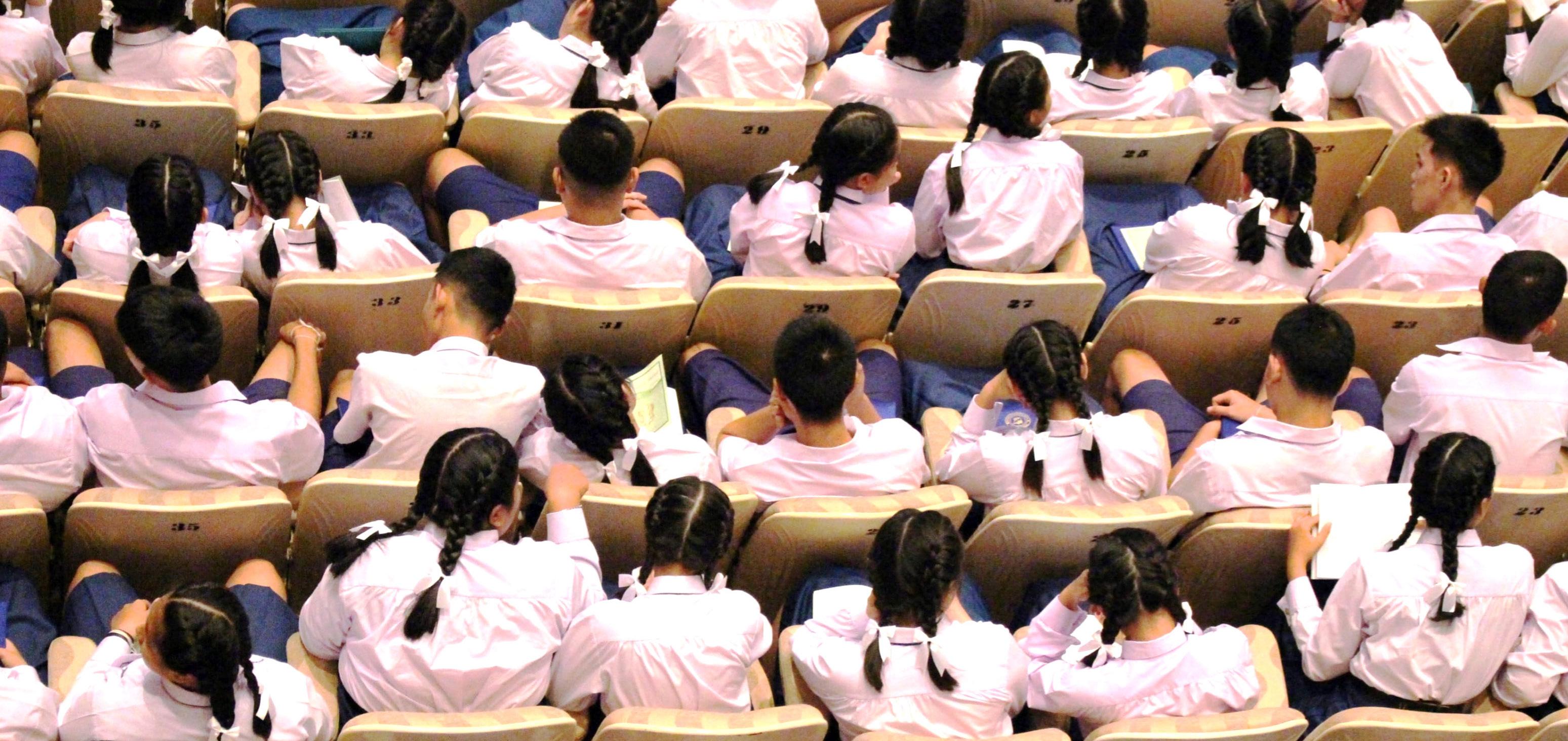
out these issues with extended planning? It would respect the staff, the students and the processes that would need to be implemented and it would demonstrate an understanding of the possible seriousness of the issue confronting the community. It would also affirm teachers who are in the front line and could, like doctors and nurses, quite literally be taking a life and death risk everyday they go to work.
Whilst sitting on surpluses, there is no shortage of cash in NSW – the state most affected and where school closures are most advanced. The government should immediately invest in resources to manage staff and student health and welfare, whilst making contingency for what provisions can be made should there be an extended school break.
Using time imaginatively, like having 3 four-hour shifts (8am to Noon, Noon to 4pm, 4pm to 8pm) it is quite possible to mandate how different stages and subjects can be taught through online media across the week – premised on the hope that the internet can cope with being used so extensively.

An educational system should demonstrate the capacity to think critically and creatively at times when the real world demands it. Time will tell whether our system is authentic to the fundamental elements of its own curriculum.
How about a longer Easter breakfour weeks or five weeks, ready to put into effect immediately?


Research at the Peter Doherty Institute for Infection and Immunity in Melbourne, recently published in Nature, has uncovered how physiological gender differences in the adipose tissue - commonly referred to as body fat - could explain why men and women are susceptible to different diseases.
Women are more prone to autoimmune diseases like arthritis and lupus where the immune system attacks healthy cells, whereas men are more prone to metabolic diseases resulting in conditions like obesity, high blood pressure, diabetes and heart disease.
That gender differences in immune systems caused this propensity was already known. What this research uncovered was the specifics of how female and male immune systems operate differently. Speaking to Indian Link from Melbourne, lead author of the research Dr Ajithkumar Vasanthakumar tried to explain the complex science and intricacies of their research. Their research was on regulatory T-cells (Treg cells) in the adipose tissue, whose primary function is to prevent autoimmunity.
“A cardinal feature of the immune system is to distinguish between cells that belong to you and cells that come from the outside,” he explained. “The immune system reacts only when attacked from outside and generally will not act against your own cells. Very rarely will the immune system attack your own cells - and this can cause diseases such as arthritis, pancreatitis, multiple sclerosis, etc, collectively called auto-immune diseases. Treg cells efficiently block the immune cells that act against your own body, thus preventing autoimmune diseases. Treg cells also play a crucial role in limiting inflammation in the adipose tissue. When inflammation in this tissue exceeds a threshold, it causes insulin resistance and Type-2 diabetes.”
It is already well known that when a high fat diet is fed to mice, male mice become obese faster than the females. What Dr Ajithkumar and his team did was to examine the body fat of mice in finer detail. They took a deep dive into the cellular underpinnings of the adipose tissue, simultaneously comparing differences in males and females. They discovered that male mice typically have three to four times more Treg cells than females.
Past research on key organs involved in the immune system, such as the lymph nodes, spleen and blood, had found no difference in Treg cells between males and females. Investigating body fat for
its influence on the immune system was novel. “Not only did we discover dramatic differences in Treg cells, we also discovered a stromal cell type that responds directly to testosterone, a hormone specific to males,” he revealed, adding that the estrogen hormone in females helps to counteract inflammation in the adipose tissue. The testosterone hormone in males has the opposite effect and hence males have more Treg cells to counteract this propensity to inflammation.
Elaborating on why body fat was chosen as the focal point of their research, he said, “Body fat is actually an organ that has a much greater role that just being a storehouse of energy. It also plays an important role in making hormones and regulates metabolism.”
In an earlier study, these researchers had found the same type of Treg cells in human adipose tissue as in mice, so they believe that similar systems are at play. This particular study which focussed on body fat succeeded in providing a fairly complete picture of cells in the adipose tissue and how they behaved very differently for males and females.

Dr Ajithkumar believes that the findings will initiate more of such research. Until now preference has been given to male mice for research into metabolism as female mice take longer to respond to a high-fat diet. He reckons that scientists need to ensure an equal representation of sexes in their research, both in laboratories and clinical trials.

The implications of this important piece of research could be ground-breaking. Dr Ajithkumar postulated, “Hopefully in the near future, gender-specific drugs will be made as this proves that the physiology of men and women is markedly different at the cellular level. Clinical trials should have equal representation of males and females. It could well be males and female need different dosages of a drug.”
He added that this research could have implications in treatment of diseases like cancers too. One of the current therapies for prostate cancer is ‘androgen deprivation therapy’ where production of testosterone is slowed. Similarly in women with ovarian or breast cancer, as one of the treatments, estrogen is suppressed. “Our research proves that modifying hormone levels affects metabolic health and this needs further investigation.”
The Doherty Institute’s primary focus is infectious diseases and the institute was the first in the word to have successfully grown the novel coronavirus from a patient sample. This will help scientists around the world to develop a potential vaccine. The panacea for coronavirus may be some time away. As an aside and parting advice, Dr Ajith advises all to follow proper hand hygiene, adding, “Stay away from crowds if possible. Exercising and building one’s general immunity is always helpful.”

employable, developing leadership and teamwork skills.
BY RAJNI ANAND LUTHRAUNSW’s Assoc. Prof Jayashri Ravishankar has been named in the prestigious Australian Awards For University Teaching for 2019.
The awards are an Australian Government initiative to recognise developments in teaching practice and student learning.
The Deputy Head of School (Education) in the University’s School of Electrical Engineering and Telecommunications, Prof. Ravishankar was cited in the category Outstanding Contributions To Student Learning.
Her transformative teaching practices have involved “developing innovative online and face-to-face learning strategies and promoting an inclusive classroom in large electrical engineering courses that improve the employability skills of students,” according to the citation letter.
“Much of my work has been with postgraduate international students, helping them get the most of their two-year stay in Australia,” Prof. Ravishankar told Indian Link.
Starting at UNSW in 2010, Prof. Ravishankar has initiated strategies that help students both complete the course to a satisfactory level and also make them
“The Australian market looks for employability rather than academic prowess, [so] I pull industry in as part of the course,” she revealed. “Not just through guest lectures, but virtual reality simulations from industry sites. Industry guests do come in and students are able to present their understanding, so that direct links are created.”
Perhaps more significantly, Prof. Ravishankar’s contribution has been in the development of online resources that are now a hallmark of her teaching practice.
“In my first lecture at UNSW I spoke into a microphone in front of 450 students, whereas in India I was used to smaller classes of 70 each,” she recalled. “The lack of direct contact with the students here rankled somewhat – I could not even see their reactions, nor understand whether they had taken something away from my lecture. Luckily UNSW had resources like recording facilities that I used frequently – to make small films and upload for students. Oftentimes students would be seeing these films as I spoke to them in class. Now of course there are even more resources, like interactive websites and VR. Yes, it is a bit of work for teachers like me, but once the resources are created, they can be regularly updated.”
These days the work starts for Prof. Ravishankar as soon as the students arrive. “They come here with no connections, so I help them build these with mentoring with
ex-students. Within the classroom, I take pains to mix the students up to increase the diversity in teams.”
This makes her work here very different to what it was like at Anna University in Chennai, India, where she taught after taking a PhD in electrical engineering.
“In India, teaching is still largely traditional - all you need is good knowledge of your subject. It is changing though - when I taught there ten years ago, we did not use online resources at all to share material, and still worked with blackboards and whiteboards.”
As well, she observed, the university dictated the curriculum from which you couldn’t deviate, because the public exams were set accordingly. “Here, I’m enjoying the academic freedom to set my own curriculum based on what is cutting edge in the body of knowledge. I’m also conscious of the fact that the way the students learn is itself changing, so we need to change appropriately.”
Another challenge – or opportunity– is the gender divide in STEM subjects.
“In India girls are encouraged towards higher education: they score the marks and gain entry into sought-after courses. Here on the other hand there is dignity of labour so ‘high status professions’ don’t exist. Girls are attracted to service-type professions because they feel they are serving society, like medicine or teaching. And then there’s the issue of a maths phobia. Our young people are not driven to do maths. I’m amazed that you can finish school here
without studying maths, unlike in India where maths is compulsory. Also, the options at high school here are much wider, so it is easy to deviate from STEM.”
Prof. Ravishankar is keenly involved in outreach for school students. “I give students a taste of electrical engineering – bringing them to labs and getting them to work on simple experiments. I like to talk to them in Year 10 about subject choices.”
She agrees that other countries might soon get ahead of us in this realm.
“I’ve been doing some work in Myanmar since 2013, helping to establish an engineering institute there by developing curricula. I’m pleased to see the classrooms there filled with girls. Just like in India, entry to these institutes are determined by marks: girls do well at school and automatically choose STEM subjects.”
What is her advice to girls then?
“Engineering is not just maths. Maths is required, but there’s lots more to engineering. You can help society directly with engineering. With some of our most pressing issues in society today – climate change, renewable energy – you can contribute directly to the nation and to society.”
Prof. Ravishankar’s own research is in renewable energy, developing microgrids for use in Australia’s remote areas and later integration into the main grid. She is also involved in taking this technology to remote areas in India - besides marketing an Australian education to Indian students.

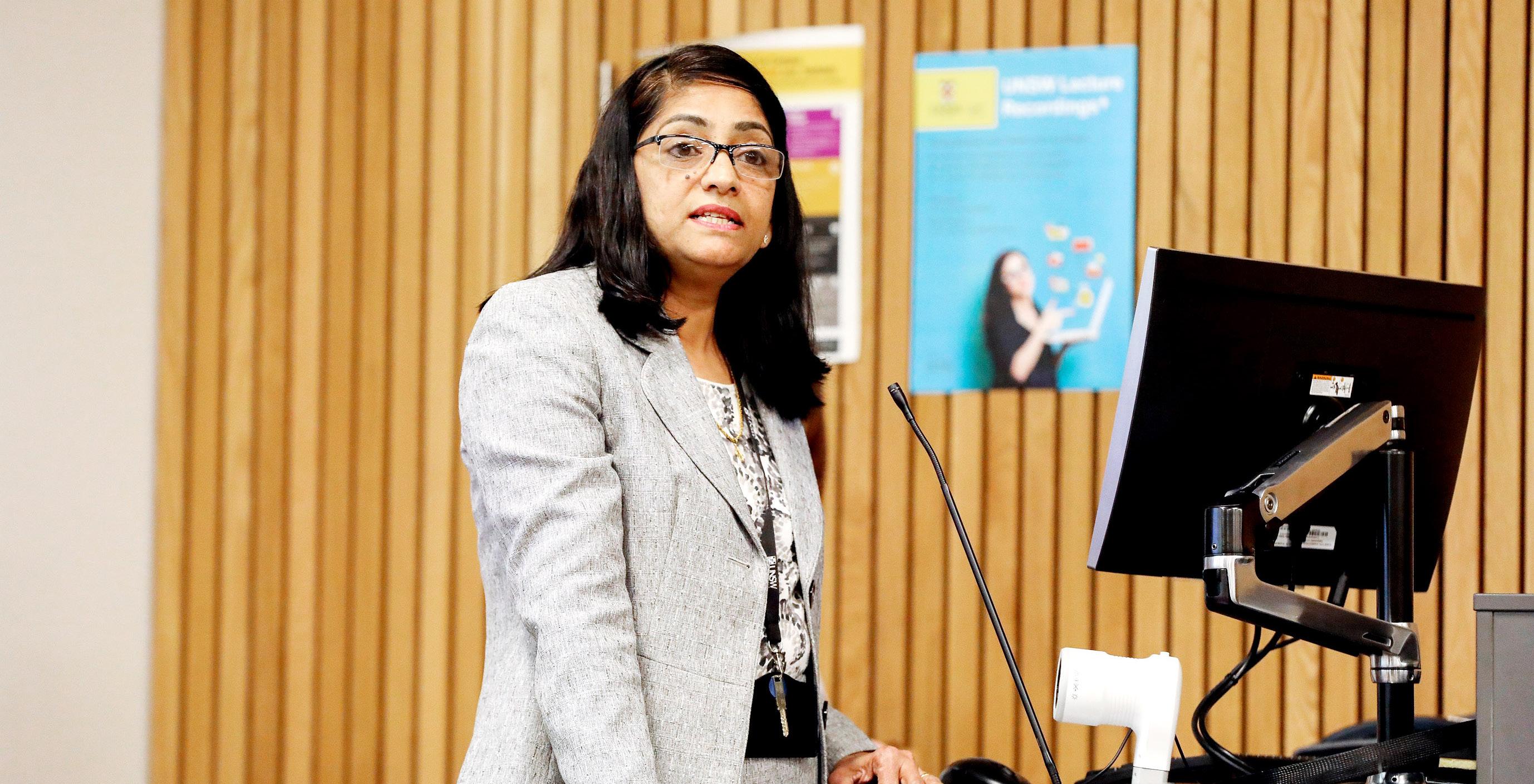
UNSW’s Assoc Prof. Jayashri Ravishankar is listed in the latest Australian Awards For University Teaching
‘
For much of the morning on Friday 13 March, I had been on the phone with Dr Rohitas Batta, speaking as well as texting about an upcoming event. I was supporting an Indian classical dance workshop, and was concerned as the venues were unavailable due to the COVID-19 outbreak.

Imagine my shock and disbelief, when I heard the next day that he had passed away in the evening.
He had been his usual self as he chatted with me, lively and full of ideas and advice to support my initiative and see it to fruition.
He was a selfless community leader and could never say no to a community member, lose hope or give up on an idea or initiative if it was all for a good cause.
I made Dr Batta’s acquaintance only months ago, brought together by Mahatma Gandhi, no less. We served on the community forum that marked the commemoration of Gandhiji’s 150th birth anniversary supported by the Consulate General of India in Sydney, Western Sydney University and City of Parramatta Council.
As an actor, artist, media and PR professional my creative ideas and concepts would inevitably be dismissed, minimised and ridiculed by others based on the sheer fact that I was younger and therefore inexperienced and had no idea of what I was talking about or even fit to speak in the team meetings. But Dr Rohitas was not one of those. He would patiently listen to each volunteer’s ideas and suggestions, and promptly respond to
every email, text or call with encouraging words of appreciation and how he could offer support.
Dr Batta was a revolutionary, open to new and progressive ideas and concepts without judging or belittling your novel approach or thinking. At the same time he would advise me of the pros and cons of it all from his
ocean of knowledge and experience and suggest a roadmap to achieve my goals. He had the compassion and strengths of a true leader and mentor and made each individual feel valued, by respecting and recognising their unique qualities, efforts and hard work. He made us feel important contributors to the process.
He stood out with his boundless energy, ever-ready smile, words of encouragement, and positive attitude.
He was the gentleman the Bollywood actor Ayushmann Khurrana describes in the video Gentleman kise kehte hai?
He was the feminist a gender-equal society needs, men who have the courage to stand by women in their lives and in society.
Dr Rohitas leaves behind his wife Meenakshi, daughter Shruti and son Himanshu.
Given my own parents and extended family are based overseas, I’m struggling to accept that I lost my guardian angel in Australia, and now have no one to call for advice and counsel.
If this was the impact he had on me in a few months of our interaction, I can’t imagine what others who knew him for a lifetime are going through.
Dr. Rohitas Batta, an Executive Committee member of Australia India Business Council (AIBC) NSW Chapter and National Co-Chair of Agriculture Industry Chapter passed away unexpectedly on the night of 13 March 2020. During his past twenty years of association with AIBC, he has significantly contributed to many initiatives at state and national levels towards promoting bilateral business between both countries.
Dr. Rohitas is survived by his wife Mrs. Meenakshi Batta, daughter Shruti Gupta, son Himanshu Batta, close relatives and many members of the Sydney Indian community.

Rohitas who was born and brought up in Punjab, India had qualified as a PhD in Agriculture from Punjab University. Dr. Rohitas had a very distinguished career of over 30 years in teaching, research, advocacy, consultancy and international relationships. Dr. Rohitas has co-
authored two books, published about 60 articles in national and international Journals and has been an active TAFE Accreditation Committee member. Some of the professional roles held by Dr. Rohitas during his illustrious career include Ministerial Consultative Committee in NSW, panel judge on NSW Government Education Ministry award committee and Multicultural Committee of NSW Government, Founder President of Lions Club of Sydney Indian, Global Organisation
of People of Indian Origin, Technocrats’ Association of Australia and People of Indian Origin Foundation. He was a Director in Bharatiya Vidya Bhavan, Sydney. Dr. Rohitas was an avid father and keen community leader always supporting many causes that directly assisted those in need, including those from the Indian diaspora who remember him very fondly.
Jim Varghese AM (National Chair, AIBC) and Sam Arora (AIBC NSW President)
He had the compassion and strengths of a true leader and mentor and made each individual feel valued, by respecting and recognising their unique qualities, efforts and hard work.Dr Rohitas Batta (1956 – 2020)


















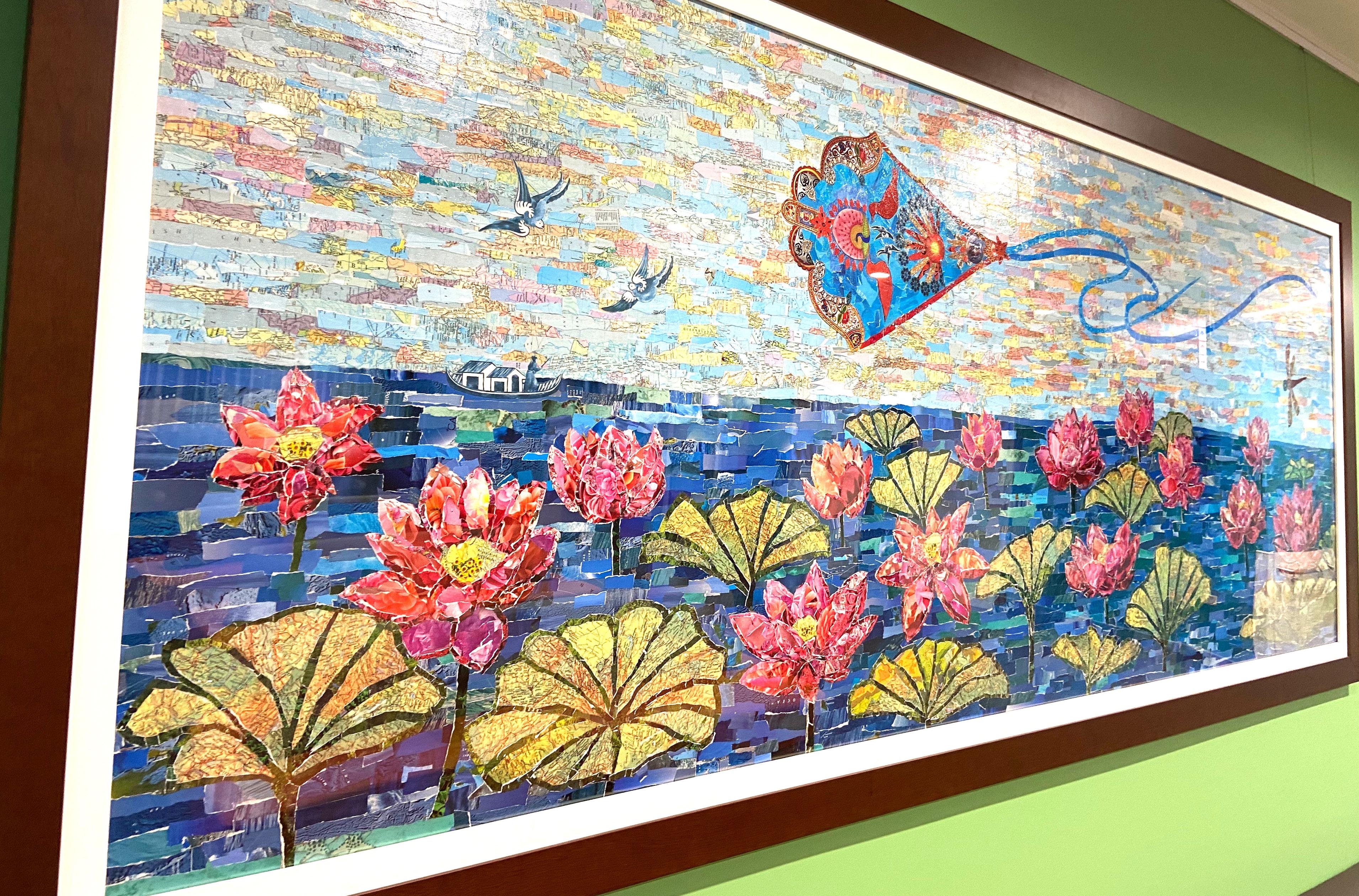
me was my teacher herself.
BY JYOTI SHANKARIwas at the Bower Reuse and Repair Centre for a workshop on reusing plastic bags recently and my teacher was a lovely woman by the name of Angela Nashaat. She sounded very Australian but looked very Indian in a ghagra and kameez with a dupatta draped elegantly over her head. Angela had made beautiful purses out of plastic fabricated by ironing different coloured plastic bags together and there were lovely bags crocheted out of yarn created by cutting plastic bags. Not a scrap was wasted and I had good fun learning about giving a new lease of life to the muchmaligned plastic bag. But what intrigued
Angela agreed to speak about her story to Indian Link, sharing it with such candour that I felt privileged to be a listener. Though the story is sad and unfortunate in many ways, it is also a story of endurance and grit and how a little girl realised her dreams.
Angela’s foray into art was both calculated and accidental. She recognised at a young age that art was what she wanted to do. However many tragic events happened in her early teens and she decided to leave home. Various circumstances brought Angela from New Zealand to Australia. She says, “I was 17 then and all I wanted was to drive a truck and paint walls!”
It was a struggle to make a living by herself and pursue her passion. She juggled both by working as a cleaner in hospitals
and doing art when she could. She did drawings for people for free or little money. “One job I did was in exchange for a camera and I started building up a visual portfolio with that. This got me more work,” she revealed, speaking of her career beginnings.
Life went by and she was soon the mother of five children. Unfortunately, one of her boys was diagnosed as terminally ill with Duchenne Muscular Dystrophy which necessitated regular visits to the Sydney Children’s Hospital. It was here that she met Marily Cintra, of Health & Art Research Centre (HARC) who commissioned artists to do art with community for hospitals. Angela was trained in mosaics for a project. This started the ball rolling. “I was soon selfemployed, figuring out how to get an ABN, learning about contracts, sub-contracting
people, how to use computers, essentially picking up skills along the way as needed, all while raising six kids, including one of my sister’s,” she described.
She was happy to be part of projects where art is used as a means to make people healthier in a holistic way. The tug of India was strong but dormant for a long time. Her parents had divorced when she was only four and Angela had met her father only three times in her life before he passed away. When applying for a passport, she saw that her birth certificate mentioned that her father was from Secunderabad and soon she found out this was in India.
In 2016 Angela made a decision to go to India. She connected with a charity online who invited her to do painting with kids they worked with. Once in Jaisalmer, she ended up painting a big restaurant

and teaching sewing and painting to many more kids. India felt immediately like home. Explaining why, Angela says, “When I got to there, I felt everything was so normal, everything was like they were supposed to be - people were kind and caring. They had so little but were content. People around were in tune with nature.”

Angela, who loved to work with her hands, was delighted to see the desert women also busy sewing, crocheting and making things by hand. Even when she thought that India was manic with regard to noise, smells and sensations, she felt a “humaneness” in life around her and a sense of things operating on a different level - “a heart level”.
Having returned to India eight times since, Angela feels a sense of belonging in the villages of Rajasthan. She has painted art in hotels in Jaisalmer and taught sustainable art and craft to marginalised children. With a tinge of sadness and acceptance, she says, “Growing up as a troubled teenager and feeling rejected time after time, I didn’t trust adults. Here


I found a family. Now I feel torn between Australia and India. I much prefer to be in India but my children are all in Australia.”


From a troubled child who lived off the streets for a while, to being a respected community artist, Angela Nashaat is now a beautiful and calm person who loves gardening, growing food, recycling, upcycling, teaching permaculture, art

and craft and writing poetry. Now having met many more family members from her father’s side, through chance and social media, Angela has reconciled to and embraced her roots wholeheartedly. “I feel more whole than ever before now,” she said with a smile. Nurturing the talent she had has taken her places. Very soon, Angela is off overseas to volunteer on an organic farm and share her creative and sustainable craft and art.
When you visit Blacktown Hospital next, look out for Angela’s lotuses which adorn the walls of the birthing unit, and kites and landscapes featured in the waiting areas, all crafted from thousands of pieces of paper torn from magazines, atlases and sheet music.


In India Angela felt a “humaneness” in life around her; a sense of things operating on a different level - “a heart level”.Angela’s Australia in Rajasthan Angela with her son Michael With kids in Jaisalmer Angela’s grandfather Angela’s workshop for recycled plastic bags
With American universities shutting down indefinitely as a preventive measure against the coronavirus, the government has asked Indian students to avoid international travel. Many students have bought tickets to come home during these difficult times. Most campuses are offering online classes because of the unpredictability of the situation.
The Consulate General of India in New York put out an advisory asking students to either stay put in on-campus housing or move in with friends if necessary.
This comes on the heels of universities asking students to leave on-campus housing, not accounting for international students who often don’t have another place to go. “If the universities are not accepting applications or have not approved applications for continued housing, ask friends if they will be able to host for the period for which the university has shut down,” the advisory said.
The consulate asked students to check with their respective universities about how to avail of health services, international student services, and any other essential services which are impacted in case on-campus services are suspended.
The consulate has advised students to avoid all non-essential travel internationally and domestically. “In case students do plan on international travel, they should check with designated school officials how any possible future international travel restrictions may challenge their F1 or J1 visa status,” the advisory said.
The government also told students that they may be put in quarantine for a minimum of 14 days, in case they plan to return home in India and will be subjected to medical screening upon arrival.
With several organisations across India implementing ‘work from home’ for their employees due to the coronavirus pandemic, hackers are turning their attention to company networks and personal computers with few firewalls and security solutions.
Over 20 lakh employees are likely to work from home in the next few weeks, but the confidentiality of their data remains a concern, according to leading experts.
“Threat actors are lurking into this phenomenon as an opportunity. Multiple instances of malicious, automated emails have been reported in several continents, including India, that are getting spooled with 'Coronavirus' as a theme,” said Sanjay Katkar, Joint Managing Director and CTO, Quick Heal Technologies.
Businesses that are unprepared for work from home scenarios are likely to have employees using personal devices that don’t have the same level of security as their corporate devices. In such scenarios, businesses and their employees must ensure the security of their data.
According to a recent survey, nearly 40 per cent of people around the world said they don’t receive technological support from their employer when they work from home or a public place. A reported 28 per cent of Indians are unaware of their router’s web administrative interface.
Jaya Baloo, chief information security officer at Avast, said that employees should use preapproved laptops and smartphones to access corporate materials.
"These devices should have business-grade security solutions installed on them and be controlled by the company IT department, if applicable," she added.
According to Devashish Sharma, CTO, Flock, the workplace collaboration and communication platform, the first step is to use a secure workplace collaboration platform that enables seamless communication across teams.
“The next step is to build awareness among employees about the risk and repercussions of a security breach, for this the top leadership has to educate themselves first about security practices,” said Sharma.
It is often a misconception that large enterprises are more at risk when it comes to data breach. “Small and medium enterprises too should take steps towards educating every individual in the organisation. Additionally it is extremely vital to empower the IT team to take decisions around security by helping
them undertake training and courses that are relevant to their profile,” Sharma said.
Following the coronavirus outbreak, the Indian Railways has cancelled 85 trains due to low occupancy in different zones from 18 March to 1 April.
Central Railway has cancelled 23 trains, South Central Railway cancelling 29 trains, Western Railways 10 trains, northern Railways five, North Western Railways four, East Coast Railways five and South Eastern Railways nine trains.
The railways even increased the prices of the platform tickets at over 250 stations from Rs 10 to Rs 50 to stop the crowding at the railway stations, as a temporary measure.

The annual three day Urs of Mughal emperor Shah Jahan, builder of the iconic Taj Mahal, will not be held as scheduled from March 21, as the historic monuments including the Taj in the city have been shut down till March 31, in the wake of COVID-19.
This will be the first time in the history of the Taj, that the annual Urs will not be held.
During the three day Urs, entry remains free and a series of functions are organised. Work on the 365-metre long chadar, to be offered, had begun. The spectacle of it being carried into the monument has traditionally been a photographer’s delight.
A member of the organising committee said convention would indeed be disrupted, but the safety of the country was more important.
The area around the Taj Mahal currently wears a deserted look. On 17 March, a pall of gloom descended as guides, photographers, taxi drivers, hoteliers were left with no work.The once crowded parking areas were vehicle free.
Agra Mayor Navin Jain had asked the Central Government for closure of the monument a fortnight ago.
Visited by around 30,000 people daily, there has been a steep decline for the past one month. (The Agra Development
Authority earned around Rs 14 crores daily from ticket sales alone).
The city’s eleven five - star hotels and around 25 three - star hotels, plus countless guest houses, dharamshalas and smaller hotels are largely without guests.
The Taj was closed on two occasions only in recent memory: during the 1971 war with Pakistan when it was shot for more than a week; and during devastating floods in 1978, when its gates closed for two days.
In his first budget, the UK’s new Indianorigin Chancellor Rishi Sunak, has abolished the much-debated value-added tax (VAT) on sanitary products. While unveiling the budget, he announced that it would be implemented once the UK formally leaves the European Union.
Sanitary products are currently taxed as luxury products rather than essential products in the UK. This move has been highly praised by campaigners and rights groups across the country.
“Today’s scrapping of the tampon tax is a landmark moment in the fight against period poverty, and it comes not a moment too soon,” said Rose Caldwell, CEO of Plan International UK, a human rights orgsnisation. “The cost of period products remains one of the leading causes of period poverty alongside period stigma and a lack of education for young people about periods.”
A survey by Plan International UK revealed that 40 per cent of girls in the UK struggled to afford period products and were forced to rely on toilet roll.
The VAT on sanitary products as luxury goods dates back to 1973 when a standard rate of 10 per cent was applied. It rose to 15 per cent in 1979 and to 17.5 per cent in 1991.
The Guardian, one of Britain’s most prestigious newspapers, has sparked outrage for printing a racist cartoon about UK Home Secretary Priti Patel. Pictured next to Prime Minister Boris Johnson, Patel is depicted as a bull with horns and a nose ring.
The cartoon, published on International Woman’s Day, has drawn fire for mocking the first ethnic minority woman to hold the office of the second most powerful cabinet post. It is also labelled offensive for antiHindu sentiments, mocking the sacred cow.
Former Chancellor and senior Conservative leader Sajid Javid called it “incredibly offensive” while the British Tamil Conservatives said that it “may constitute a hate crime”. Trupti Patel, president of the Hindu Forum of Britain, accused the newspaper of “crossing the boundary from legitimate reporting into blatant racism.”
“The Guardian have just lost any crumb of credibility they had left,” tweeted Conservative MP Steve Double.
The cartoon was created by popular artist Steve Bell. It was published related to allegations of Patel bullying her staff. She is currently facing inquiries of breaking the
ministerial code while a spokesman said that she categorically denied these allegations.
Students enrolled in public schools in Fresno, California will now be able to learn the Punjabi language through an after-school program. This is part of a new Global California 2030 Initiative by the Fresno Unified School District (FUSD). Other languages offered as part of the program include Spanish, Frenchand Arabic. Through this, the California department of education wants to equip students with world language skills and cross-cultural competencies and prepare them to succeed in a global economy.
Currently, the languages are being taught in five elementary schools with one language taught in each school. They are at a beginner’s level, but the syllabus is planned to expand to three years of language skills.
The initiative hopes to triple rates of biliteracy in the state of California, established 100 state-approved bilingual teacher preparation programs, and double the number of teachers authorized to teach in two languages.
Two Indian-origin researchers have led their teams in Australia and the US to develop coronavirus-specific risk checker apps to counter the fear and confusion caused by the pandemic.
Abhi Bhatia, CEO and co-founder of Medius Health, an AI digital health company based in Sydney, launched his platform in the first week of March. It can be used to educate the public, deliver accurate information regarding symptoms, and quell fears. Meanwhile, Arni SR Srinivasa Rao and his team from Augusta University in the US will be launching their platform shortly.
In the app, individuals fill up detailed questionnaires, then an AI uses an algorithm to assess their information and provide a risk assessment of either high risk, no risk, minimal risk, and moderate risk. It also alerts the nearest facility that a health check is required. The app gives users easy accessibility to important coronavirus related information and helps in early intervention.
According to Uber’s 2020 Lost & Found Index, Mumbai is India’s most ‘forgetful’ city followed by Kolkata and Allahabad. Predictably, phones, wallets, and bags topped the list of common forgotten items.
Delhi was #4 on the list with Bangalore ranking at #5. The top 10 most forgetful cities were rounded up by Kanpur, Mangalore, Agra, Varanasi, and Patna.
Some of the most unique items lost in an Uber in India were an artificial tooth, a teddy bear, balloons, exam notes, a bottle of Dettol, a broom, and a game of Tambola. According to the index, people were most likely to forget their lunch in the cab on Tuesdays, Wednesdays and Thursdays while
they were most likely to forget their business card holder on Mondays and Fridays.
Last year, the most ‘forgetful’ day was August 3, 2019. Other‘forgetful’ days included July 6, August 31, June 30 and July 27.
Understandably, the post-lunch lull between 1 PM and 3 PM was the most common time of day to forget items.
A research team led by an Indian-origin scientist at the Massachusetts Institute of Technology (MIT) are working on developing robots that can learn how to do basic chores. Their system gives robots the human-like ability to weigh ambiguous and contradictory requirements to meet an end goal. They compiled datasets of information about how eight objects - a mug, glass, spoon, fork, knife, dinner plate, small plate, and bowl - could be placed on a table in various configurations.
“The vision is to put programming in the hands of domain experts, who can program robots through intuitive ways, rather than describing orders to an engineer to add to their code,” said Ankit Shah, a graduate student in the Department of Aeronautics and Astronautics (AeroAstro) and the Interactive Robotics Group.
A robotic arm first observed randomly selected human demonstrations of setting the table with the objects.
Then, the researchers tasked the arm with automatically setting a table in a specific configuration, in real-world experiments and in simulation, based on what it had seen.
To succeed, the robot had to weigh many possible placement orderings, even when items were purposely removed, stacked, or hidden.

Normally, all that would confuse robots too much. But the researchers' robot made no mistakes over several real-world experiments, and only a handful of mistakes over tens of thousands of simulated test runs.
Robots are fine planners in tasks with clear "specifications," which help describe the task the robot needs to fulfill, considering its actions, environment, and end goal.
The researchers' system, called PUnS (for Planning with Uncertain Specifications), enables a robot to hold a "belief" over a range of possible specifications.
“The robot is essentially hedging its bets in terms of what's intended in a task, and takes actions that satisfy its belief, instead of us giving it a clear specification,” Shah noted.
The researchers hope to modify the system to help robots change their behaviour based on verbal instructions, corrections or a user's assessment of the robot's performance.
“Say a person demonstrates to a robot how to set a table at only one spot. The person may say, 'do the same thing for all other spots,' or, 'place the knife before the fork here instead,'” Shah added.
Disney Junior is set to debut its newest CGI-animated, mystery-adventure children’s show titled Mira, Royal Detective inspired by Indian culture. The show is about a resourceful eight-year-old girl named Mira who is appointed as royal detective by the Queen and travels across the kingdom to solve mysteries and help people.
The show will feature plenty of South Asian voice talent like Kal Penn, Freida Pinto and Jameela Jamil. Mira is voiced by 16-year-old Leela Ladnier in her professional debut.
According to executive producer Sascha Paladino, “The biggest piece in terms of authenticity was making sure (they) included as many South Asian voices in the process as possible.”
He is previously known for the hit show Doc McStuffins about an African-American girl who aspires to be a doctor, using her stuffed toys as potential patients.
To ensure authenticity, the show included many South Asian voices in the creation process, including writers, designers, and even a cultural consultant.
Kal Penn, who voices Mira’s sidekick mongoose and is the son of Gujarati immigrants, is excited to introduce this cultural diversity to a new generation.
“They don't carry the emotional baggage
or institutional memory of what it was like for us growing up with a lack of content on TV, they just don't have that,” he said. Mira, Royal Detective has already been renewed for a second season prior to the first season’s debut.
An Indian student in Prayagraj has developed a variety of star jasmine flower that can now withstand the cold weather conditions of north India. Extensively used in temples and worship rituals, jasmine flowers traditionally did well solely in warm weather.
The new jasmine variety has been developed by Chandra Shekhar, a M.Sc student of Sam Higginbotham University of Agriculture, Technology and Science (SHUATS) in Prayagraj. In north Indian states like Uttarakhand and Uttar Pradesh which witnesses temperatures as low as 3 to 4 degrees Celsius, the plant has not survived.
“After 10 months of trial and error, we were now be able to harvest the flowers in extreme winter, besides peak monsoon seasons too,” said Chandra Shekhar.
The new 'all-season star jasmine' has a long stem and bold buds with a pink tinge.
The buds bloom into a white star-shaped flower with usually 10 petals that are leaner and longer. The flowers are mildly fragrant and the leaves are dark green and glossy.
Dr S.S. Saravanan, associate professor of horticulture at SHUATS, and Chandra Shekhar's guide in the project, said that the longer life span and shelf life of the star jasmine could now promise round-the-year income for farmers.
“(It) can certainly change the pattern of flower cultivation here and revolutionize the agriculture sector. It can also replace the common jasmine because it is more affordable,” he said.
There is also a high demand for fragrant jasmine that is also used to make essential oils for a wide range of cosmetic products. IANS
The 2007 ICC World T20 heralded a new beginning for international cricket, ushering in an era of franchise-based leagues and sparking the biggest revolution to the game since World Series Cricket in the 1970s. In many ways, the recently concluded 2020 Women’s T20 World Cup promises to have an equally big impact on the women’s game. As broadcasters, sponsors and fans start to appreciate its value from both a commercial and entertainment perspective, the common thread underlying these watershed moments is an Indian team that captured the imagination of its adoring fanbase.
Australia may have lifted their record fifth T20 World Cup crown, thrashing a despondent India in a one-sided final, but if anyone was happier than the formidable home favourites, it was the ICC organising committee, who could not have scripted a more perfect outcome if they tried.
It is no secret that India and Australia playing a World Cup final on Australian soil is the stuff of dreams for organisers, broadcasters and sponsors, let alone the fans themselves. To have the colour, fervour and pure fanaticism of Indian fans, while seeing the home team ultimately lift
the trophy in front of tens of thousands of jubilant fans, is a guaranteed moneyspinner.
In this sense too, there were parallels with the 2007 World T20, where India eclipsed a resurgent Pakistan in another hugely anticipated final. When MS Dhoni led his unfancied side to that title, the T20 format was still seen as a bit of a “hit-andgiggle”. But once the BCCI realised the potential in the format – spurred by India’s success – it took less than a year to launch the IPL, which has been nothing short of staggering in its success.

Similarly, like T20 cricket itself, women’s cricket has in many corners been viewed as somewhat of a novelty. It formed its own niche often only as an accompaniment to the men’s game, with women’s matches broadcast on subsidiary channels with second-rate production standards, often played as curtain raisers to a men’s match.
Some of those elements will remain for the medium-term. Sports entertainment is a highly saturated market, and
athletes today already play more days of competitive professional sport than ever before. There is only so much room in the calendar, only so many venues, and only so many broadcasting resources available for another market entrant.
But we can certainly expect two things in the fall-out from the tournament. First, the creation of more stand-alone franchisebased women’s cricket leagues, which will provide a much-needed influx of private funds into the game. It will build greater depth, encourage new talent and attract new sponsors. Though there are some of these already – of which the WBBL is one – none could ever match up to the riches of a women’s IPL, which the BCCI is no doubt seriously considering.
Secondly, it’s likely that boards such as the BCCI will start pouring money into the development of women’s cricket, particularly at the national level. As an organisation now accustomed to seeing its men’s team atop the world rankings, the BCCI will no doubt seek similar success
for its women’s teams, particularly with Sourav Ganguly at the helm. This will mean more girls’ academies; more highly trained coaching staff; greater emphasis on strength, fitness and conditioning, and more talent scouting.
In that sense, it may not actually matter that India did not lift the title. In fact, the BCCI may be even more motivated to improve Indian women’s cricket given the clear gap in talent, ability and fitness between the two sides in the final.
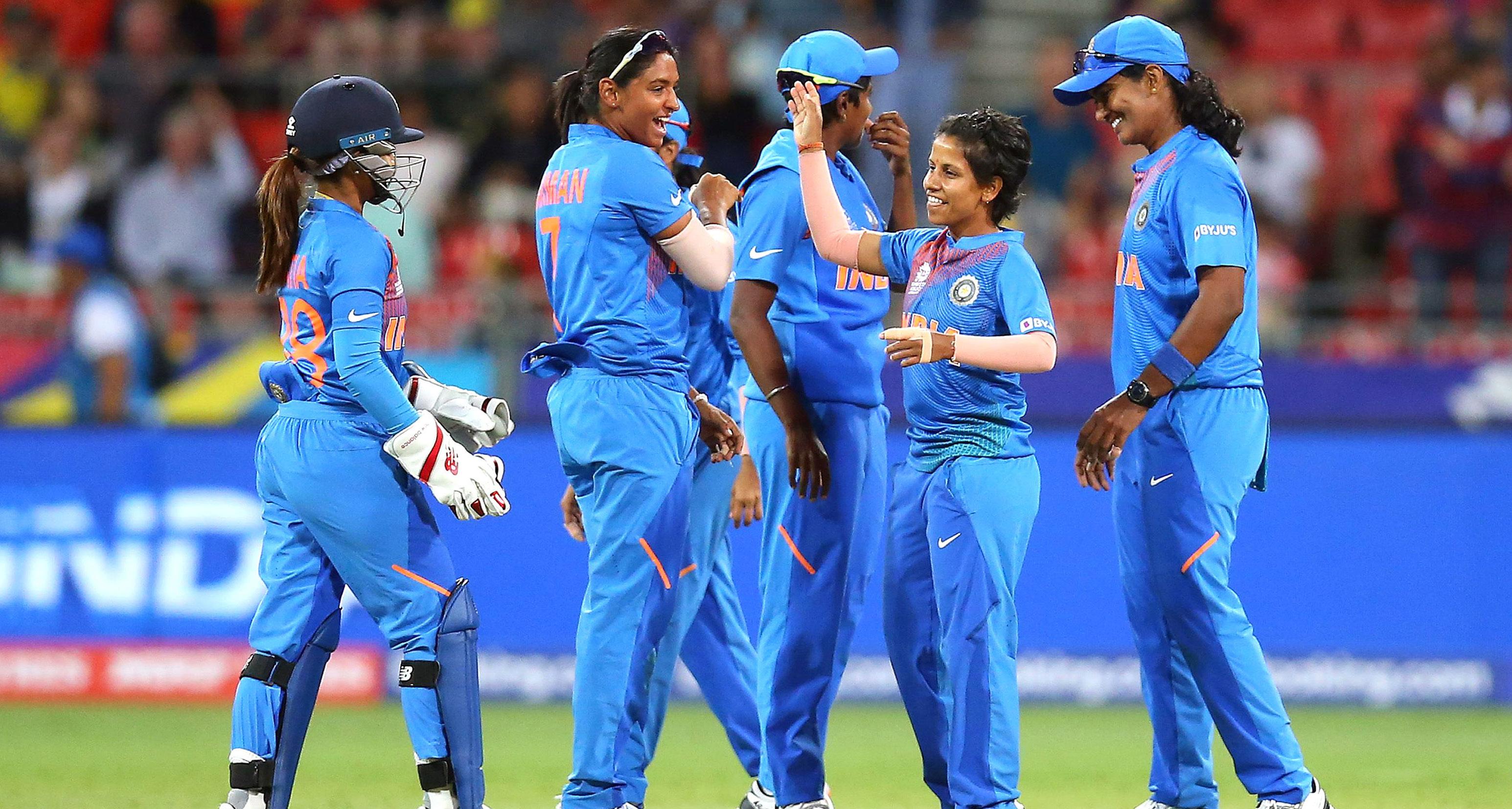
Those criticising the Indian team would do well to remember how many years it took the men’s side to become a formidable force in international cricket. Although it is perhaps not the fairest of comparisons, the fact remains that women’s cricket in India is still in a development phase, especially next to the relatively robust domestic and international structures in place in Australia and England. Despite this, the team has performed admirably, including two wins over Australia in this tour alone.

It is self-evident that the women’s game is more professional, dynamic and entertaining than it has ever been. There’s a reason that more than 87,000 fans voted with their feet and came up just short of the world record for the highest ever attendance at a women’s sporting events.
Fans will continue flocking to the game if organisers keep backing it; and the 2020 Women’s T20 World Cup may well become the blueprint for success.
The Indian women’s team may have lost the World Cup finals to Australia, but they won where it matters – convincing stakeholders of the potential of the sport
We can expect the creation of more stand-alone franchise-based women’s cricket leagues, and the pouring in of money into the development of the sport at the national level.

The tournament needed a big opening match, and it was no surprise that organisers turned to India and Australia to deliver. The two teams had already had a number of close encounters in the pre-tournament tri-series, and India had shown that it was more than capable of challenging the home favourites. Through it all though, there was a sense that come the World Cup proper, Australia would find their A game.
Halfway through the opening match, it seemed that the match would indeed fizzle out into a one-sided encounter, as India limped their way to what seemed a belowpar 132 despite a bright start. Those fears were compounded when an Alyssa Healy blitzkrieg saw Australia blast India away in the opening stages of the second innings.
Enter Poonam Yadav. The diminutive leg spinner - known for bowling incredibly slow, loopy leg spin - first claimed the dangerous Healy before really turning the screws, dismissing vice-captain Rachel Haynes and all-round great Ellyse Perry in consecutive deliveries. Cruelly, wicketkeeper Taniya Bhatia dropped an edge off Jess Jonassen to deny Yadav what would have been a historic hat trick, but Yadav soon returned to claim her fourth and finish with 4-19, as
India decimated the Australian middle and lower order and romped home to victory in front of a near-capacity crowd at Sydney Showground stadium.
The tournament, which was desperate for true competition to avoid the sense of inevitability that rightly accompanies the Australian side, was blown wide open.

Thailand hold their own
A side making their tournament debut, Thailand won the hearts of many with a feel-good journey for the ages. Even before the tournament began, the Thai team was the apple of the cricketing world’s eye, with captain SornnarinTippoch noting, “We're excited. Very, very excited…this is a very proud moment for us; it's the first World Cup for us and we've been preparing for a long time. Now it's our time to shine."
The heartstrings were only further tugged when New Zealand's White Ferns sat down with the Thai girls after a drubbing in a warm-up match to share their knowledge, with the sides splitting into focus groups comprising bowlers, spin bowlers and batters.
Though the team unsurprisingly struggled in their first few matches, Thailand notched up an impressive 150/3 against Pakistan in their final game, and were unfortunately denied the chance to defend the total, which would have required a record chase by Pakistan.

Before the tournament, there was plenty
of hype around India's star 16-year-old opener, Shafali Verma. Verma herself made no secret of her ambition to make a name for herself on the biggest stage, citing her desire to help those less fortunate with their cricket playing dreams.


Verma did not disappoint, blasting 163 runs at a strike rate of more than 158 –higher than anyone else in the tournament – and with only a single score under 29. Unfortunately for Verma, that score came at the most critical time, in pursuit of a mammoth Australian total in the grand final.
That disappointment brought Verma to tears. However, Verma can take comfort in the fact that few 16-year-olds are feared in any professional international sport, and yet she is definitely one of them. Verma’s hyper-aggressive brand of play may not always come off, but when it does, she is as ruthless as they come.

Though organisers got their dream final in the end, it seemed a long way out three days before the grand final, with a characteristically miserable day in Sydney forcing the first semi-final between England and India to be washed out. With no reserve day – a decision for which the ICC were widely ridiculed – India, as the higher-ranked team in the group stages, progressed to their first ever final.
For much of the day, it seemed inevitable that Australia, too, would meet the fate to which the English team were condemned, with Australia’s semi-final opponents South
Africa placing first in the group stage. However, a miracle effort by the groundsmen ensured that the match was able to proceed, with Australia stealing the match by just 5 runs and booking a date with destiny.
Cruelly for England, had they been the second scheduled semi-final, they could have had an opportunity to contest for a place in the grand final.
Melbourne fills the MCG
Has there been a more iconic moment in Australian sport in the last 20 years than the sight of a near-capacity MCG crowd cheering on women’s cricket? It’s difficult to compare, but surely this must rank alongside those great moments etched into Australian sporting folklore; Cathy Freeman at the Sydney Olympics, Lleyton Hewitt’s Wimbledon title run in 2002, Steve Waugh’s century off the final ball of the second day’s play in Sydney in 2003.
Over 87,000 fans packing a sold-out MCG – in the middle of a global coronavirus scare, no less – is evidence enough. Pre- and post-match concerts by Katy Perry also lifted the tournament’s credibility, while it was a stroke of genius to schedule the final on International Women’s Day.
It is difficult to fathom, but many hope for this kind of crowd at women’s matches to be a stepping stone, rather than the glass ceiling. With an enormous cricket stadium in Ahmedabad now open – with a staggering capacity of 110,000 – all it will take is for the BCCI to start its own women’s IPL before the public have the opportunity to see even more attendance records being broken.
With the ICC Women’s T20 World Cup now behind us, we look back on some of the tournament’s most memorable moments as fans, players and organisers alike reflect on one of the most successful women’s sporting events in history.Poonam Yadav One to watch: Shafali Verma Disappointed England Thai surprise Hearing the roar
Abhilasha Agarwal, a rare Indian woman in cricket photography, was in Australia recently for the ICC T20 Women’s World Cup
BY RAJNI ANAND LUTHRABangladesh 2014. The ICC Women's World Twenty20 tournament is on.
A young Indian girl steps out on to the field. It’s her first international event.
The momentous nature of the occasion dawns on her. It’s been a major personal journey for her to get here.
Then, she looks down at her equipment and realises how utterly unprepared she is.
I can’t back out now, she thinks; I’m living my dream.
She walks with her camera to a fellow photographer setting up close by and asks if she can borrow one of his lenses. ***
“I own several lenses now,” Abhilasha Agarwal laughed as she spoke with Indian Link on the sidelines of the recently concluded ICC Women’s T20 World Cup.
The Baroda girl also owns some 80,000
photographs of cricketers – all women.
Having won the Bangladesh gig through thoroughly unorthodox means – she landed up at the stadium and hassled media officials until they let her in, because Indian authorities had brushed her aside – Abhilasha is now recognised by the ICC as well as the Asian Cricket Council. It puts her in a rare breed of women in India involved in sports photography.
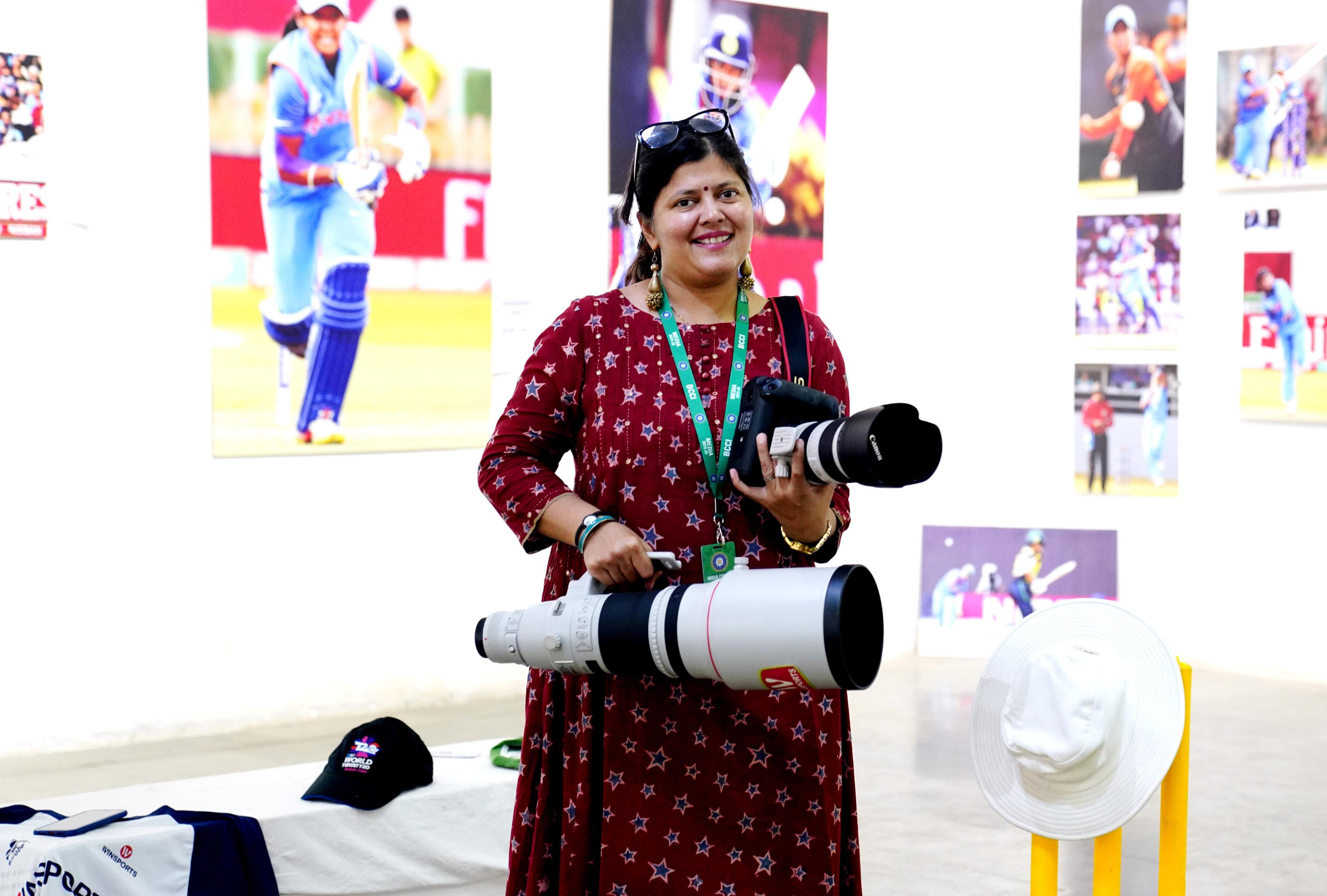
The self-taught professional claims though that she would rather have been a cricketer.
“I played lots of gully cricket, and there was just no opportunity to take it up further,” she revealed. “As a huge cricket fan - and an even bigger supporter and enthusiast of women’s cricket in particular - I took to blogging about the women’s game.”
She discovered however that it was difficult to find photos to accompany her pieces.
“I found a few of Jhulan Goswami and Mithali Raj and random ones of an up-andcomer called Harman Kaur, and that was about it.”
While India’s male cricketers were becoming major stars with fan followings to rival those from Bollywood, no one wanted to photograph the female players.
“It was frustrating that no one had pictures, and there was no major archive on the journey and growth of women’s cricket in India.”
It was then that Abhilasha realised she would have to take her own photos. She picked up her simple generic cameraand Winsports, her small entrepreneurship firm for sports images and blogging, was born.

***
The platform grew, and Abhilasha began to travel around the country.
“When the 2014 Women’s Twenty20 came along, I sought accreditation. It was denied; I was told that official photographers were already on the books. So I bought my own tickets, and when I wormed my way on to the grounds, I found the official photographers would stay around for about 20 minutes and then just up and leave! There was simply no interest in the game or in the players.”
She managed to get some good shots –with the borrowed lens.
Abhilasha then covered the 2016 men’s and women’s competition, and her photos began to get picked up.
“I began applying with greater vigour, and for the Asia Cup I managed to become official photographer. I’ve now done two Asia Cups, many bilateral series, and this was my seventh World Cup.”
In 2017 she produced a coffee table book, launching it at the England World Cup. In 2019 she followed it up with another one, coming out with a one-ofits-kind photography exhibition of India’s women cricketers called The Game Changers. Received well by the media, the exhibition was attended by the entire women’s team.
What have been her favourite shots, over the years?
“Smriti Mandhana in action,” she replied without hesitation. “Also Harman’s sixes and her facial expressions.”
At the crux of it all however, the secondclass treatment continued, and does to this day: media platforms are happy to run her
pics if she contacts them, but no one pays.
“Because I’m freelance, I pay my own way through. In this World Cup for instance I’ve paid extra on every flightincluding within Australia – because my hand luggage of photography equipment is heavier than the stipulated seven kilos. I’ve carried three Canon lenses, a monopod and a tripod!”
So how does she finance her trips?
“Yes it’s an expensive ‘hobby’ but it has never been about the money,” Abhilasha laughed. “This is my passion: other women buy diamonds and handbags, I want to get out there and take photos of women playing cricket.”
She added thoughtfully, “I choose to do this, it gives me much satisfaction. When I enter the ground to cover Team India - I have this immense sense of pride to be able to capture the precious moments of our team. And that I am the only Indian - certainly the only woman - to have done this for the last three World Cups. I hope to become the first ever woman photographer to have covered more than 10 international Women's Cricket events.”


On this very tour, Abhilasha found herself to be the only woman in the photographers’ pack and in the media rooms. “I’m so happy to say that the guys have all come up to me and had a chat, and many have said it’s good to see me part of it all. They’ve treated me like one of them; today one of them said your lenses are bigger than you!”
Her stand-out shots this tour, she revealed, have been Poonam Yadav rejoicing, and Shafali Verma batting.


“I can safely say I have shots of every single Indian player – mine must surely be the largest archives of photos of our
young team.”
She gets much regard from the girls themselves. “They often tell me, Didi aap aaye ho to hume apni photo dekhne ko mil jayegi (You’re here so we know there will be photos of us for sure) and because of you our team has been archived.”
What about the Australian players?
“I’ve loved photographing Meg Lanning, and the bowlers.” ***
Having been involved with the tournament over its entire length, Abhilasha has some interesting observations to make as well.
“I think the quality of the game has gone up,” she remarked. “I enjoyed all of India’s matches, Aus-South Africa, and Thailand-Pakistan. And not just with the cricket in every other aspect as well, the entire experience has been memorable – the crowds, the facilities provided by Cricket Australia, and the

arrangements by the ICC.”
What about the final moments of the tournament?
“I was right there taking it all in but didn’t have the heart to photograph the girls in tears! Billie Jean King, I thought, was wonderful – so inspiring as she consoled our girls and brought their spirits up. When women support each other, incredible things happen.”

Did the dreaded virus shut down this year’s Holi?
At Indian Link Radio, we had a perfectly legit celebration.
Relax, of course we did the socially and morally responsible thing: there were no crowds, no liquids, no mess, but there sure was plenty of colour.
We ran a photo contest called Photogenic Holi. In this contest which ran from 2 to 10 March (Holi was on 9 March), our listeners sent in their favourite Holi pics from previous years.






Entries came in from across the
country – showing people of all ages and sizes - but three of four winners turned out to be Sydneysiders (no bias!).
Saloni Khandwekar Bahuguna, Aarti Mehra and Tanav Gupta have won dinner vouchers from Colors of India Restaurant Parramatta, valued at $100 each.
Canberra’s Jahnavi Mehta won double pass movie tickets for her entry.
Congratulations! And thanks to all entrants for participating in our messfree, fuss-free 2020 Holi!
Ekta SharmaAstreet library has been launched at 146 Fairwater Boulevard, Blacktown – breathing new life into a love for books and community.
Called the ‘146 Fairwater Boulevard Free Fun Library’, it is the brainchild of local resident Guneeta Khanna and is Blacktown’s first library of its kind.

“While we are lucky to have local libraries in most suburbs in Australia, young people are finding less and less time to visit them,” Guneeta observed, talking about people’s changing relationship with books since her arrival in Australia back in 2000.
“Reading is still such an integral part of today’s world,” she told Indian Link. “However, with a regular Joe’s life being so busy, online reading has become the norm. There is a certain joy in resting a book on one’s knee, flicking through the pages and placing a bookmark within them. As a teacher myself, this is something I regularly encourage in the classroom.”
Guneeta, author of All You Need To Know About Tarot (2001), has always herself held a keen love for reading - ignited by her father and grandfather. It is a love that slipped onto

the back burner in recent years, she admitted, amidst being a working mum and life’s everincreasing commitments. However, a recent holiday cruise with her husband Kapil Khanna re-ignited the cherished pastime - ultimately leading to the launch of this thoughtful new community-focussed venture.
The 146 Fairwater Boulevard Free Fun Library operates as an ‘open sourced’ platform: leave a book and take another one. Anyone is welcome to donate books and expand the resource base of the library.
The community library was officially inaugurated in early March by Blacktown
City Councillor Moninder Singh. Addressing the gathering at the event, he said, “We appreciate and thank Guneeta Khanna for her initiative to share books with her neighbours and the wider community. We at Blacktown Council hope that Guneeta will share the know-how of setting up and running a street library.”
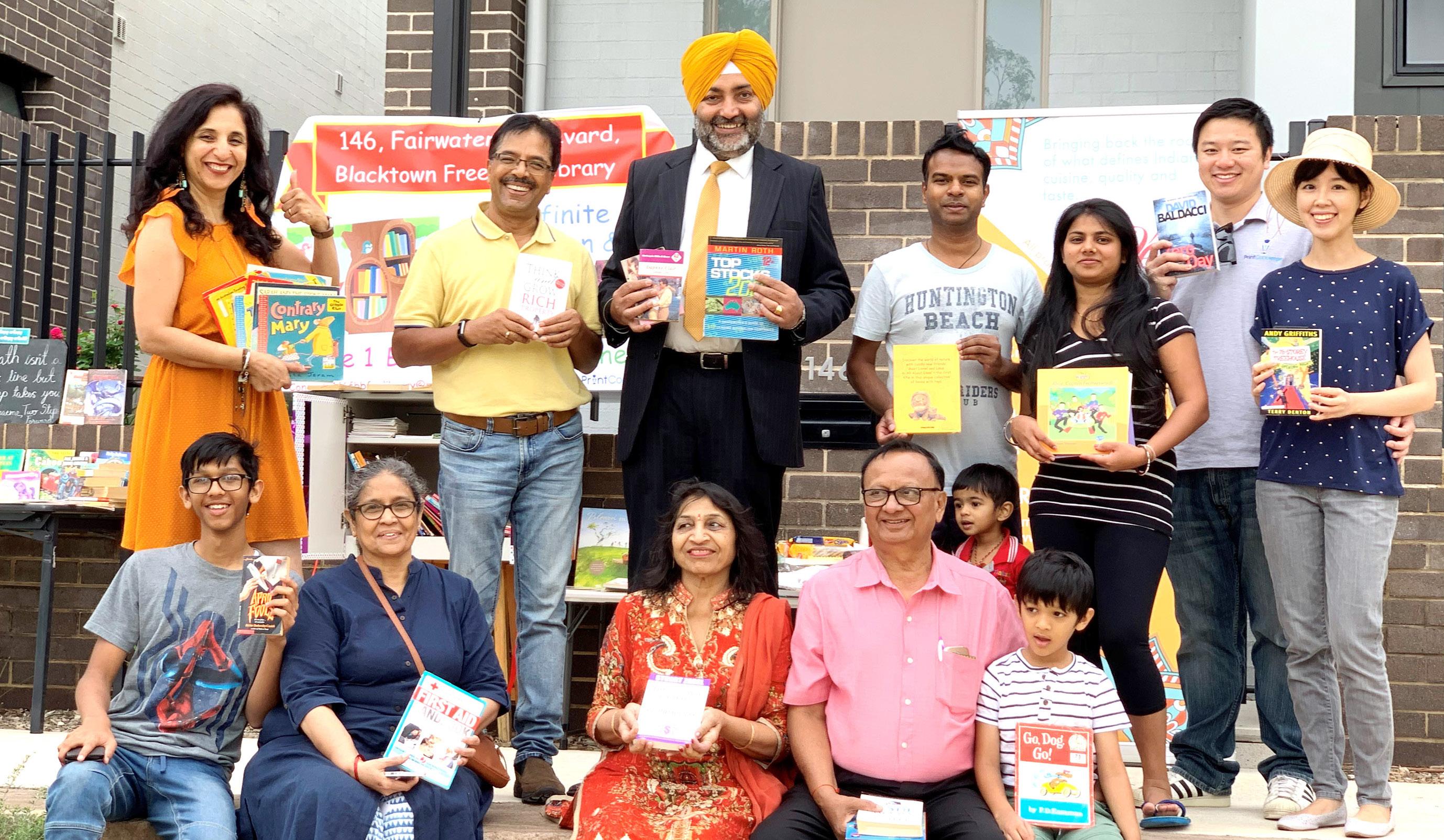
He laid emphasis on the need for more people to pioneer similar projects. “This endeavour to provide free access to books is unique and will encourage the masses to engage - both with books and with each other.”
Blacktown City Council has pledged to donate books to the library.
Local community members showed their support by being present at the event, donating books and borrowing a few that caught their fancy. Seven-year-old Vivaan Aggarwal read aloud from one of the library’s books.
Local businesses pitched in as well. Jai from Print Concierge and his wife Kerry sponsored two large banners. Everyone at the event was treated to a delectable bite of ballushahi, kindly sponsored by Pure Desi sweets.
An enthusiastic resident Om Dhungel commented, “I have always believed in books. They have shaped and changed my life for the better. Having ready access to books will encourage people to take up reading. It will also help create friendships amongst the members of the community.”
The author Jorge Luis Borges famously fantasized that Paradise would be one large library. While many surely look forward to seeing this for themselves, in the meantime, there are tiny pockets of Paradise here on earth. ‘146 Fairwater Boulevard Free Fun Library’ is one such pocket and one cannot help but cheer Guneeta Khanna along as she sows seeds to foster a love of books and stronger bonds within the community.
For further information on the library or for guidance on starting a street library, email 146fbbfunlibrary@mail.com
A new community venture is breathing life into a love for books and for community.
When Indian students arrive in Australia, they’re often enthusiastic about the opportunity to work alongside their studies. But as time goes by and job applications are left unread, it can be demotivating. Eventually, they’re convinced that it’s impossible to get a job here!
In our newest segment, we want to help students whose efforts need a little fine-tuning. Getting a job can be difficult, but it doesn’t have to be impossible. With a few tips and tricks, let’s help you get hired!

First thing’s first: know that ‘resume’ and ‘CV’ are used interchangeably in Australia. For part-time job applications, it should ideally be 1-2 pages about yourself – a summary of your experience, skills, qualifications and interests.
Where do I begin?
• A reasonable structure to follow is: your education (including your current university degree), your work experience and/ or internships, your extra-curriculars and achievements (that shouldn’t date back more than 4 years), your skills (like knowing how to use Photoshop), and finally, your interests.
• Start listing down items in a document. Start in reverse chronological order, meaning you begin listing what you’re currently doing before talking about an internship from 2015.
• A good rule of thumb is listing not more than three major achievements/ roles that you accomplished in your work experience. Think critically about what you’d like to say for each job, leadership role or internship.
• If you have previous experience, reach out to your employers for references. It’s best to have them ready (or at least warn them that someone might call!) should your application be successful.
What should I say?
• Tailor your resume to the job that you’re applying for. If you’re applying to be a barista, you don’t need to necessarily explain your college dissertation… unless you perhaps wrote about coffee. Recruiters can take less than a minute to reject an application, so you want the first things they read to be relevant and important.

• Try to use keywords from the job
posting! If the barista job asks for ‘stock management’, ‘latte art’ or ‘customer service’, address the ways you meet these requirements.
• If you previously worked for an Indian organisation that may not be known in Australia, include one or two sentences about them too. Consult the organisation’s ‘About Us’ page for ideas. What do they do? How long have they been doing it?
• If you don’t have a lot of experience in making coffee but you did two internships in marketing, it is noteworthy. But discuss them after you address the current job application.
How should I say it?
• When talking about previous experiences, be concise and clear. Use active verbs like ‘organised’, ‘assisted’, ‘created’ rather than ‘I helped’ or ‘I wrote’.
• Avoid pronouns like ‘I’ altogether! They’re unnecessary because it’s already assumed you wrote your own resume.
• Don’t forget to proofread! One of the worst things you can do is call yourself ‘detail-oriented’ with dozens of spelling mistakes across your resume. Remember that you need to show your skills from the get-go.
• Often, we read our own work so much that we overlook errors. Ask a friend or classmate to proofread it too.
• When in Australia, use Australian spellings! Some common examples include ‘analyse’ instead of the American ‘analyze’ and ‘colour’ rather than ‘color’.
• You can even change your language settings on Microsoft Word to English (Australia) to help you out.
What should the resume look like?
• It’s a marketing device to show yourself off to an employer. Make sure your resume looks professional and neat.
• Use bullet points and short sentences rather than paragraphs. White space is your friend!
• Consider fonts like Times New Roman, Arial, and Calibri. It’s best to use one font throughout the document.
• Use font sizes 10 or 12 for the body of your resume and 14 (in bold or underlined) for your headings.
• Unless you are applying for a creative job, don’t use too many colours. Stick to black or dark blue.
Other tips
• Consider your online presence. Recruiters can look you up to understand you better as a candidate. What does your LinkedIn profile say? What message does your Facebook display picture give?
• When providing your contact details like an Australian phone number, make sure your voicemail message sounds professional! A reasonable message is: ‘Hi, this is (insert name). I’m not available at the moment, please leave your number and I’ll call you right back’.

And there you have it! Consider this a beginner’s guide to building a resume for the Australian job market.
Craving a movie fix but can’t burn another hole in your wallet with a $20 ticket? Worry not, for cinemas in Sydney are giving all kinds of discounts to students! Dendy’s Cinemas in Newtown has not one, not two, but three days of student deals! For just $8, you can catch up on the latest Bollywood movies all day on Wednesdays, Thursdays, and Fridays. They’ve even got a special student combo which throws in a beer (Urban ale) and a Choctop with your ticket for a total of $12!
When: Wednesday, Thursday, Friday
If Newtown isn’t exactly close, Event Cinemas ought to be your next pick. Located in Bondi Junction, George Street, Parramatta, Hornsby, Hurstville, Macquarie and even Wollongong, their student offer lets you buy tickets for $8 every Monday. You do need to be a Cine Buzz member to claim this offer, but don’t worry –membership is free.

When: Monday
PS: Both locations ask to see your student ID card for verification, so don’t forget to carry it along!
Listening on repeat this week:
• Dus Bahaane 2.0 (Baaghi 3)
• Haan Main Galat (Love Aaj Kal)
• Dheeme Dheeme (Pati Patni Aur Woh)
• Humraah (Malang)
• Pyaar Tenu Karde Gabru (Shubh Mangal Zyada Savdhan)
#IndianLinkLoves: Mere Liye Tum Kaafi Ho by Ayushmann Khurana
Halfway through watching my first film in an Australian movie theatre, I realised that I really needed to go to the washroom. When I asked my friend (who had already seen the film) if the intermission was coming soon, she laughed. Imagine my horror when I found out that the concept of an ‘intermission’ only exists in India!
One of my university professors to swear. If a projector stops or her phone dies or something goes wrong in her class, first person to drop the F anyone else feel awkward professor cusses?
Tell Mum you made…
Spinach-Mushroom Fried Rice
Total time: 20 mins
Serving size: 2-3 people
Total cost: $18 (approx.), $25 with chicken
INGREDIENTS
Spinach $2 for 60g

Mushroom $2.2 for 200g
Long white rice $1.4 for 1 kg
Turmeric powder $1.9 for 35g
Salt $1 for 500g
Chili powder $1.6 for 35g
Garlic $3.5 for 80g of paste / $1.5 for 60g of individual pieces
Ginger $3.5 for 80g of paste / $4.6 for 120g of individual pieces
Onion $1.9 for 1kg
Vegetable oil $2.2 for a 750 ml bottle
OPTIONALINGREDIENTS
Chicken mince $6 for 500g
Tomatoes $1.1 for 150g
Garam masala $2.8 for 200g
DIRECTIONS
Put 1 ½ cups of rice in a rice cooker/

pressure cooker with 3 cups of water and leave it to boil.
While the rice boils, chop mushrooms, spinach and onions finely, and throw them into a heated pan with oil.
(For the non-veg version, add your chicken mince in a pan before the vegetables since it’ll take longer for the water in the mince to evaporate. Take your time with cooking this - otherwise you’ll be left with soggy meat!)
Season with salt and pepper and stir it all up.
Once the rice is cooked, introduce the vegetables and stir. Add chili powder, turmeric powder, garlic and ginger. 3-5 minutes more of stirring, and dinner is ready to dish out.
professors loves stops working something else she’s the F bomb. Does awkward when their
One of the first few times that I visited a pub in Sydney, I ended up sitting at my table for nearly ten minutes looking for a waiter to take my order. I had no idea that out here you order your drinks at the bar!
Don’t know about you but I still struggle to call my professors by their name. They always smile when I refer to them as “sir” or “ma’am” and say gently that don’t have to call them that, but it just feels weird calling them anything else.
Being a university student in Australia can be some of the most exciting years of your life. You get to meet new people, enjoy new experiences, and explore life in a new country. But these can also be some of the loneliest years. You can feel homesick, demotivated, anxious, or even depressed.
If you feel like this, you certainly aren’t alone! Studies have consistently shown that close to 70 per cent of university students report having poor mental health. So what should you do? Where should you go?
Feeling this way is totally normal!
Whether this is your first time in Australia or you’ve visited before, living in a different country with an entirely different way of life can be daunting. It is understandable to feel anxious or overwhelmed.
If you’re tempted to hide out in your room on particularly bad days, remind yourself of the reasons you came here. Listen to some music, go for a walk, and clear your head. Try to run some errands to keep yourself moving without having to focus too much, like doing your laundry or cooking a meal.
How is everyone else doing so well?
Occasionally, your negative feelings might be made worse by your other Indian friends who seem to be adjusting perfectly. Aren’t they nervous about taking buses alone? How are they learning a new currency?
Just keep in mind that they may have other struggles that you do not. Comparing yourself to other people isn’t fair, and it certainly isn’t productive –there’s no one else who is quite like you!
It’s good (and healthy) to talk it out If you’ve made even a few friends that you feel comfortable around, don’t hesitate to open up to them. They might be feeling the same way!
This paneer has gone bad…? When my mother visited me in Sydney for the first time, she went grocery shopping alone while I was in class. She ended up buying a huge bar of feta cheese thinking it was paneer and didn’t realise until after she started making ‘paneer’ parathas!
If you’re struggling to make friends, there’s no shame in that! Australians might be more boisterous or outspoken than you’re used to, but they’re also some of the most welcoming people if you give them a chance. Try to join clubs that match your interests; you’ll get to meet other students who love the same things as you, and as we know, that’s always a great base for any successful friendship.

Time management and lesson planning can go a long way! Instead of letting your assignments pile up, leaving you stressed and sleep-deprived, be proactive about your studies.
Invest in wall calendars or Post-It notes to keep track of important dates and submissions. Allot a few hours every week to your readings, meetings, and general studies - you’d be surprised how easy it can be to lose track of the reason you came to Australia in the first place. Create study spaces where you can focus solely on your work. Experiment with a few different places like the university library, a café close to your house, or even study rooms in the university till you find the right fit.
Every university has a counselling centre because they recognize how difficult student life can be, especially for international students. Make an appointment to meet a licensed professional who can listen to you and help you, if you need it. There is no shame in reaching out if you need some additional help.
You’ll also find that your university professors are very understanding if you are honest with them. They may provide you with extensions for assignments, direct you to appropriate avenues if you need academic assistance, or simply lend an ear.
Remember, you’re not alone in this!
Got a funny Culture Shock story to share? Send it in to us at media@indianlink.com.au
Following the success of Hindi Medium in China since its release in 2017, makers of the film are supposedly considering the next instalment already – this time in China! Producer Dinesh Vijan shared a happy incident of being recognised for the film during a visit to China in 2019 when a waitress at a restaurant came running to tell him how she’d seen the film with her young daughter and that “it really connected” with her.
“With Angrezi Medium, we have taken the story out of our country, and because the daughter is older and wants to study in the UK, the crisis is bigger for Irrfan's character, who, this time, is a single parent,” Vijan explained. “Since the Chinese are all around the globe and are sending their kids abroad for higher studies while struggling with the language barrier, I think the world now deserves a Chinese Medium!”
Now wouldn’t that be fun?

In the wake of the coronavirus pandemic, all Indian filmmakers and producers have decided to temporarily halt filming. In a notification issued by the Indian Motion Pictures Producers’ Association, Federation of Western Cine Employees and other similar bodies, they’ve announced that work for films, TV shows, and other formats will be suspended until 31 March.
Good on you, Bollywood, for coming together in these unpredictable times!
As of the day of the announcement, the Union Ministry of Health and Family Welfare has confirmed 107 cases of the coronavirus in India.
Just days prior, films like Salman Khan’s upcoming Radhe: Your Most Wanted Bhai were still shooting in Mumbai although makers insisted they were adhering to safety norms by the World Health Organisation (WHO). Even Kartik Aaryan had posted pictures of the cast and crew in masks on the set of Bhool Bhulaiyya 2.
Due to the coronavirus, several cinema halls have shut down in India and movie releases have been postponed. Showings of recently released movies like Baaghi 3 and Angrezi Medium have been paused while upcoming releases like Akshay Kumar-starrer Sooryavanshi have been

GUESS WHICH ACTOR?
One might think times are changing with pay disparity and sexism being discussed in Bollywood. But some stars aren't that progressive. This A-list hero who has made an unconventional film with "his favourite co-star" is now refusing to join a big-banner womencentric political drama with her because he's a bigger star than her today and is not comfortable playing second fiddle. Sometimes success comes at the cost of friends!
GUESS WHICH DIRECTOR?
This director's first film is the biggest surprise hit of 2020 so far and he’s on
the list of many producers. It was almost a given that he would make his second film with the same team which included a top actor/producer. Unfortunately, he was lured by another producer with a fancy cast and more money. The director couldn’t resist and signed on, pissing off the actor/producer who is now giving him a cold shoulder. No wonder there’s no success party!
GUESS WHICH ACTRESS?
This famous actress has been taking on socially relevant, women-centric projects in recent times. Apparently, it’s gone to her head – she allegedly doesn’t treat her staff well and keeps screaming
delayed indefinitely.
Bollywood stars have been regularly reaching out to their fans to stay responsible and listen to health advisories. Parineeti Chopra posted a two-page letter on social media.
“While all of us have the 'luxury' to be house arrested and waiting for news, please spare a thought for the doctors and medical staff around the world who are risking their lives, away from their families, to save us! Exactly like our soldiers do at a war,” it read.
Even Big B Amitabh Bachchan took to Twitter requesting fans to stay safe and not to gather outside his bungalow Jalsa for their weekly meet-and-greets.
Angrezi Medium brings back Irrfan Khan as the male protagonist opposite Radhika Madan as his daughter. Directed by Homi Adajania of Cocktail and Finding Fanny fame, the film also stars Kareena Kapoor. It is set to release in China in a few months’ time.
In his memoir Made In India, model-actor Milind Soman has spoken out about his time with the Rashtriya Swayamsevak Sangh (RSS) as a young boy. He discussed visiting the local ‘shakha’ (training centre) in Shivaji Park, adding that his father saw great physical and mental benefits in being a junior cadre of the RSS.
He said he feels “baffled” reading about all the “subversive, communal propaganda the media attributes to RSS shakhas” as his memories of evenings spent there were completely different.
Soman recalls how activities included
and shouting for little things. A far cry from her back-to-back successes last year! She‘s even left journalists in the lurch without giving interviews and her attitude has taken a 180-degree turn.
GUESS WHICH FILMS?
Word on the grapevine is that the biggest of the multi-starrer films this year had to postpone their Italy shoot. Now they plan to do interior scenes first, hoping to shoot outdoor sequences later this year in Europe. Another ‘90s film remake is almost complete - except for a song to be shot in the Far East. Now they’re going to Ooty or Ramoji Studios in Hyderabad instead!
marching about in khaki shorts, practising yoga, working out in an outdoor gymnasium, going on camping trips, and chanting Sanskrit verses that the young boys didn’t understand.
He said he was inspired by the team of adults who conducted the activities, calling them most well - meaning adults who “truly believed they were helping raise good ‘civilian soldiers’.”
He also recalled how his father had been a part of the RSS himself. While he didn’t understand what there was to be proud about, there was “not much to complain about either,” according to the model.
The revelation had social media abuzz. In response to this, the model took to Twitter with a witty response: “Trending at 54 for an experience I had at 10. Wish it was about swimming, which was at the same time!"

In a surprisingly candid reveal, Saif Ali Khan recently said that he had to earn back his ancestral palace in Pataudi after his father passed away since it was rented out to a hotel chain.

He said many people have had fixed notions about his royal heritage, but that he did not actually inherit the palace.
“The house I'm supposed to have inherited has been earned back through money from films. You can't live off the past,” said the actor who is known for his work like Omkara, Sacred Games, Love Aaj Kal and Parineeta.


After the death of his famous father, cricketer Mansoor Ali Khan Pataudi back in 2011, the palace was rented out to Neemrana Hotels. It dates back to the 1930s when it was built by the eighth Nawab Iftikhar Ali Khan Pataudi Ali Hussain Siddiqui and is valued at a whopping Rs 800 crore. It has over 150 rooms and a working staff of over 100 people.
“There is history, culture, beautiful photographs; and, of course, some land. It has been a privileged upbringing. But there's been no inheritance,” Saif clarified.

Ayushmann Khurrana is understandably happy with the warm response by filmgoers to his gay romance Shubh Mangal Zyada Saavdhan. As Bollywood’s first same-sex romance, it was a gamble – and it paid off!
“When you do a film on a taboo topic, you have to first plan on how you are going to spread the message to as many people as possible. So, for us, when we decided to take up an important subject like legitimacy of same-sex relationships, we decided to do it through humour,” he said.
Ayushmann knew it was a tricky subject to deliver to audiences, but that it was necessary to trigger a conversation within families. “We decided that we will entertain them thoroughly while giving them something to ponder over. I’m delighted that our crucial social message movie has done well,” the actor beamed.
Although the closure of movie halls due to the coronavirus has impacted showings, Shubh Mangal Zyaada Saavdhan was declared a semi-hit at the box office, grossing over Rs 82.5 crore worldwide.

Ayushmann hopes that films like this make producers ready to put their money on important cinema. Clearly, the film’s success shows that an evolving India is ready.
Despite a legendary acting career in films, did you know Rajnikanth has never appeared on the small screen? Well, he has now made his TV debut in Into the Wild starring alongside Bear Grylls.
Rajnikanth visited Bandipur Tiger Reserve for this episode with the Discovery Channel survival star. He can be seen riding an All Terrain Vehicle (ATV) in the jungle, balancing on a metal bridge in the middle of the forest, and wading through a deep pond in the reserve.
“Superstar @Rajinikantha's relentless positivity and never give up spirit was so visible in the wild as he embraced every challenge thrown at him,” tweeted Grylls with a teaser video of the episode.
The video ends with Rajnikanth wearing his trademark sunglasses, saying “This is the real adventure”.
Back in mid-2019, the show featured none other than Prime Minister Narendra Modi who joined Grylls at Jim Corbett National Park in Uttarakhand.

The date 8 March 2020 held a special significance to lovers of cricket this year as on this International Women’s Day, the ICC attempted to break the world record for the largest attendance at a woman’s sporting event. The finals of the ICC T20 Women’s final at the MCG came close to the 91,000 record with over 86,000 in attendance.
Event sponsor MoneyGram also used the opportunity to throw their support behind this as they brought the local Indian Australian community in Melbourne together in a pre-game function. Legendary Indian cricketer and former Indian captain Mithali Raj was in attendance.

On the morning of the grand final between Australia and India, Raj shared her experience saying that the Indian team had done very well in reaching the finals. “Cricket is such a strong force in India and it is good to see the women doing so well,” she said. “Their very presence here will be a great motivation to the thousands of young girls around the world, especially in India.”
Anil Kapur, MoneyGram’s Head of Asia Pacific and South Asia, who flew in from Mumbai for the finals, said that MoneyGram is proud to be a sponsor of the ICC T20 games. “Cricket touches many lives and it’s truly exciting to be a part of this sport and witness its potential to inspire and transform lives firsthand,” he added. “Money Gram has been a part of cricket for many years and we’re pleased to see the increasing
to 26 years, settled in Australia. He is an Australian citizen, a degree-holder and is working full time. Please email details with photo to chandshaadi2020@gmail.com
Brisbane-based 46-year-old male, Australian citizen, Hindu, seeks match. Divorced, kids living with former partner. He is an engineer by profession in the mining industry. Seeking Australia-based bride aged 45 years and below; religion no bar, divorced/widowed ok, but must be willing to relocate to Brisbane. Contact 0448 323 029.
Seeking professionally qualified, settled match for 46-year-old Sydneybased, never married Australian Citizen, Hindu, Punjabi (Khatri) lady, 5'3" slim, fair and attractive. She is a postgraduate, working in a good position in a government organisation. Please email details with photo to Indsyd2016@gmail.com.
Seeking professionally qualified, settled match for 45-year-old Sydneybased, never married Australian Citizen, Hindu Punjabi (Khatri) man,6’,athletic build. He is aproject manager with an engineering background, working in a private organisations. Please email details with photo to Indsyd2016@gmail.com.
Parents of Fiji-born,26-year-old Hindu boy, tall, from respected family are looking for an educated and honest bride aged 23

Seeking suitable match for a handsome, never married 34-year- old Hindu Malayalee boy. 5’9”, born and brought up in Australia. Well educated and works for a leading bank in Sydney. Seeking a girl between 24 -31 years old, caste no bar. Please send details with photos to bausv2020@gmail.com
Seeking match for Australian born Punjabi Sikh (Khatri)man. 30-year-old, respected lawyer in Melbourne. Girl must be Sikh and permanently settled in Australia. Please emailchanpreetmohali@yahoo.com or WhatsApp +61423932282.
Indian Christian Protestant parents seeking a suitable match for their 39-year-old son. He is a Software Engineer, born and brought up in Australia. Seeking a Protestant girl between 31-36 years old. Please email sammy5073@gmail.com or call 0403836360.
participation of women in the sport. With a love of cricket that transcends gender, we continue to commit to cricket sponsorships that provide ways for our customers to connect with the sport and bring fans closer to the game. As a brand built on the connection of people through money transfer, cricket is a natural fit that enables us to provide unique opportunities for customers to engage with MoneyGram and cricket at the same time.”
MoneyGram is keen to work closely with the communities from the sub-continent and support them, especially in their passion for cricket. (India’s favourite cricketer Virat Kohli served as the face of MoneyGram for some time.)
“As we also build up to the men’s T20 in Australia later this year, we at MoneyGram will work towards connecting the community to cricket. A host of activities will roll out between now and October to leverage cricket and further connect with the South Asian diaspora in Australia,” he added.
MoneyGram is currently running its “Send and Win” cricket campaign, where customers who send money overseas before 30 April 2020, will be entered into a draw to win one of six Apple Watches. With cellular capabilities, the Apple Watch will enable winners to not only stay connected to their loved ones, but also to the latest cricket scores and updates. For more information, visit www.moneygram.com.au.

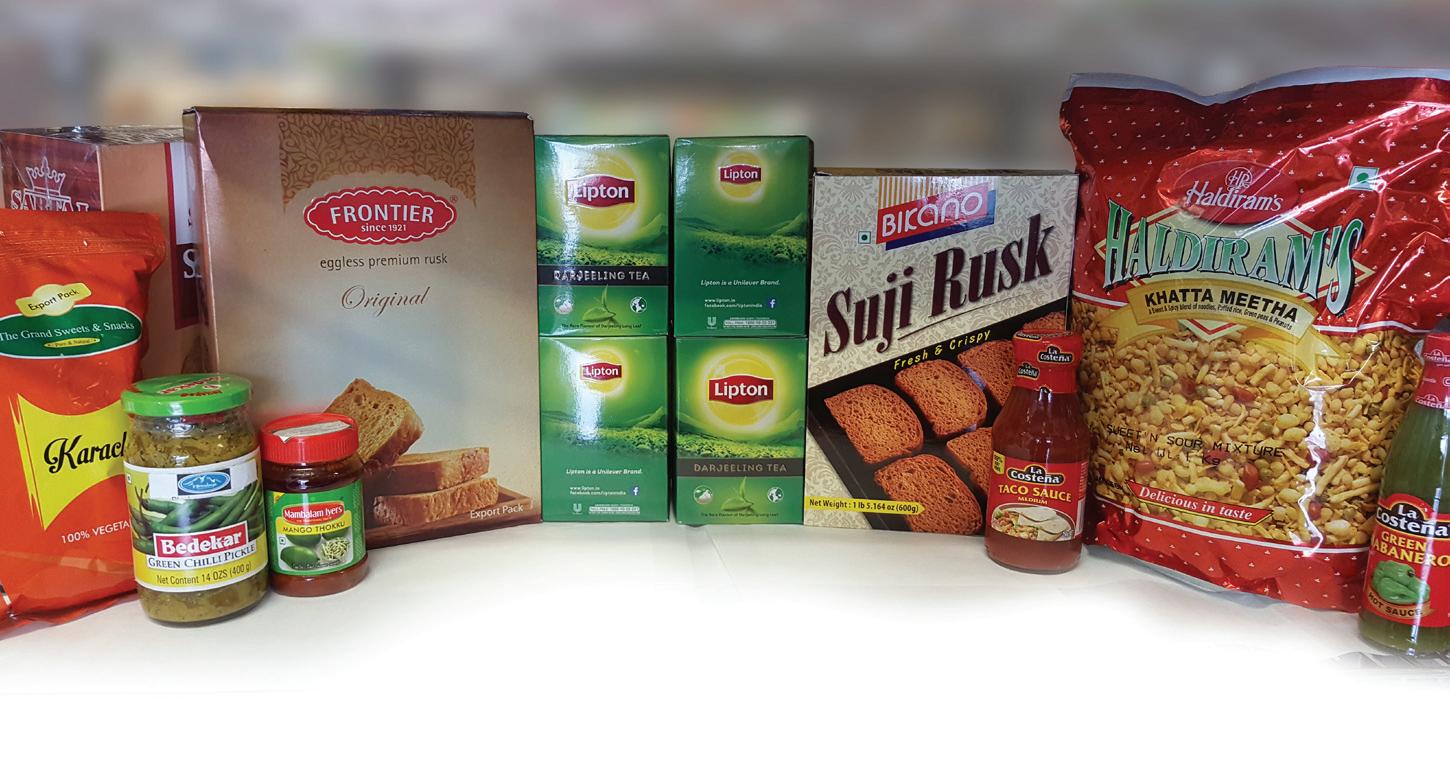
STARRING: Irrfan, Deepak Dobriyal, Radhika Madan, Ranvir Shorey, Dimple Kapadia, Kareena Kapoor
DIRECTOR: Homi Adajania
H H H
A couple of great performances can actually turn an utterly mediocre film into okay stuff, you realise watching Irrfan and Deepak Dobriyal in Angrezi Medium. Homi Adajania's follow-up to Saket Chaudhary's 2017 comedy hit Hindi Medium is a stand-alone story that bears no link with the first film by way of plot or characters and is, quite frankly, not a patch on the original. There are the sporadic brilliant scenes and the random bursts of humour, but the overall storytelling simply falls short, faltering every now and then. It's almost as if the writers were not quite sure how to push the narrative beyond
a point, especially in the second half.
The film begins by introducing Irrfan as Champak Bansal, owner of one of two Ghasitaram sweet shops in the same locality of Udaipur - the other belonging to his brother Gopi (Deepak Dobriyal). The two brothers are normally busy bickering over whose shop represents the ‘real and original’ Ghasitaram brand. Champak is a single parent, taking care of his teenage daughter Tarika (Radhika Madan). The girl has a big dream. She wants to pursue higher studies at a top university in the United Kingdom.

The film tries setting up adequate drama using that premise, as the narrative moves from Udaipur to London. In the process, the story also tries creating space to talk of too many issues. There is the obvious theme of the young generation's fetish for foreign universities, and
the question of how expensive worldclass education continues to be. The screenplay also talks of teen rebellion and generation gap. A cameo by Dimple Kapadia is used to highlight loneliness among the aged.
Somehow, all of these comments don't add up to much, owing to weak writing. As the minutes pass, you sense the classic 'Sequel Syndrome' taking over - it is almost as if this film was made because the idea worked the first time, and it seemed lucrative enough for a second outing.
The urge to squeeze in too many sub plots and characters takes its toll as the film, after an engaging buildup in the first hour, meanders in the post-interval portion before reaching a rather insipid ending. What rescues the film from sinking are the three performances that matter. Irrfan, Deepak Dobriyal and Radhika Madan
are first-rate.
Towering above all with a simply flawless performance, Irrfan proves once again why he will always be special for Bollywood buffs. He clearly relishes every bit of being Champak, bringing alive the nuances that define the good-natured, small-town businessman's quirks with ease.
Perhaps his performance would have seemed incomplete without the comicmelodramatic chemistry he shares with Radhika Madan, as Champak's daughter Tarika. Angrezi Medium is primarily a father-daughter story and Radhika matches Irrfan's screen presence admirably to light up the screen in their scenes together.
Deepak Dobriyal is a delight to watch as ever - if only Bollywood had more imaginative roles for him than the hero's sidekick. To his credit, Dobriyal finds a zillion ways to reinvent that stereotype, you realise watching him go in Angrezi Medium.
Pankaj Tripathi elicits a few laughs in a cameo, Kareena Kapoor was quite honestly never needed in this screenplay, and Dimple Kapadia could have done with a stronger role. Ranvir Shorey and Kiku Sharda bring alive their roles with innate talent.
What amazes you is that Adajania has employed a battery of four writers - Bhavesh Mandalia, Gaurav Shukla, Vinay Chhawall, Sara Bodinar - to come up with such an aimless script that offers utterly half-baked characters to a cast that seemed awesome in the opening credits.
We would perhaps have ended saying Angrezi Medium is a good idea gone waste - except that as the storyline slips with every passing minute - you begin to wonder if there was an idea to begin with.
Vinayak Chakravorty



Oh no, you’re thinking, not another column on the cursed coronavirus!



Folks, before your cry goes viral, calm down, wash your hands, wear your mask, and read on. This one is to shine a light on our national character. We Aussies have a sense of humour like no other. While the English variety is subtle, and the American decisively brash, ours sits somewhere in between, in the outer or maybe down under. We manage to raise a chuckle even at the worst of times. For example the current COVID-19 crisis seems to have brought out the wackiest in us. The ‘run’ for toilet rolls has ‘flushed’
out a flood of funny lines on the dunny business. The media - print, electronic, social - is overflowing with toilet humour, plumbing the depths of Aussie witticism. Commentators are ‘loo’ dicurously lucid as they ply their craft on the 3-ply rolls.


To overcome shortage, one letter-writer to a newspaper reminded readers of the toilet habit of yore - tearing newspapers up into squares and hanging them on a hook in outdoor dunnies. ‘Today’s newspaper is tomorrow’s wipe. Perhaps I should start saving your paper’. I was surprised the editor ran it. Was he admitting his paper’s worth?!
Another gem is from a lager lover lamenting the future of his favourite Corona Lager. He is not sure if the brand will be abandoned, or whether to down a few more bottles to prevent the virus. His preference, I guess, is for the latter. Conspiracy theories also abound.
According to one, China managed to mask the outbreak until the hoo-ha about Wuhan’s soaring death toll. A cynic suspects that China’s ambitious One Belt One Road project may have helped the virus to travel so far and so fast to Iran and Italy. Many have called this crisis an ‘overkill’ compared to the death toll of the annual flu. Besides loads of tips from health experts and briefings from politicians, psychologists are having a field day analysing the mass hysteria of Aussies’ tussle for loo paper, leaving supermarket shelves bare, baring their teeth and even brandishing knives at fellow raiders. A well-known columnist has likened our behaviour to South African wildebeests galloping en masse. Another columnist characterises the Aussies as a flock of sheep: ‘when one moves others follow.’ (Until now, the sheep jokes were on our neighbours across the ditch). A cartoonist has caricatured us as lemmings
rolling over a cliff hanging on to toilet rolls. Meanwhile, an overseas mate texted me to say he nearly fell off his (toilet) seat when he saw viral footage of the tug of war for toilet paper among three women in a Sydney store.

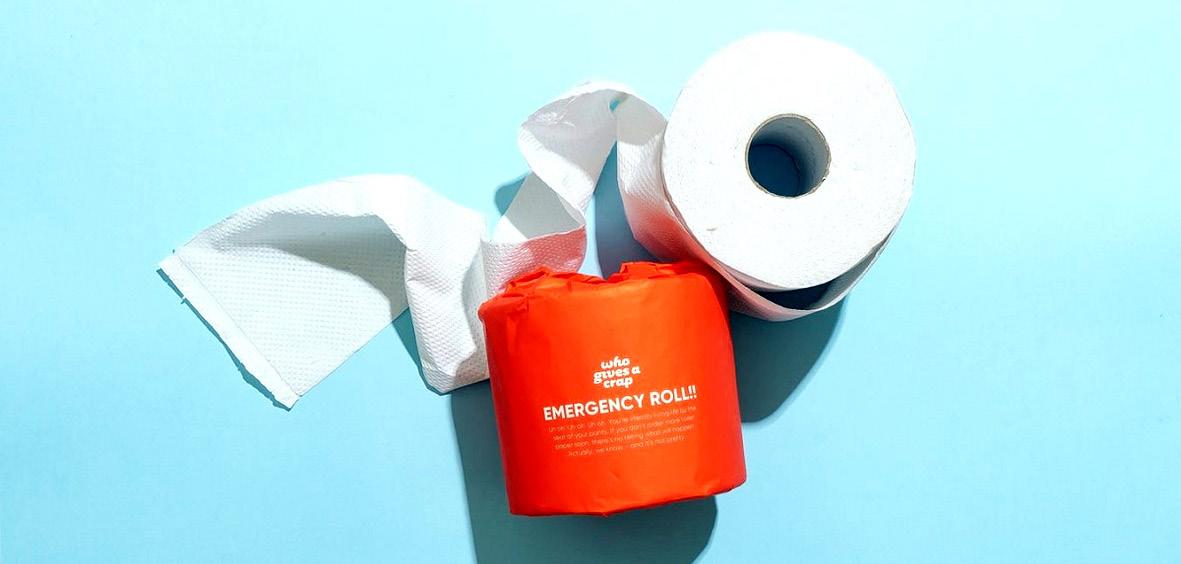
There would be no need for such duels if only people placed in their bathrooms a BMW (bum mechanical washer), a flexible tubing with a water spout. This oriental practice will also save tons of tissues, conserving millions of trees and pleasing climate change activists. You listening, Greta?
For my part, I wrote a letter to my local paper saying ‘It is corona, not Caroma virus’ (Caroma is a famous brand of toilet seats made in Adelaide, sadly closed now). It didn’t make it to print - given a clean wipe at the editor’s desk, no doubt.
Hope this piece doesn’t get similar treatment.

send Money Overseas most reliably and securely within 10 minutes through moneygram send Money to any bank account at the best rate and flat fee of $15 (No Limits applicable on amounts) exchange your currency with us, we give the best rates and do not charge any commission send money to our own branches in all major towns and cities in Fiji and New Zealand Ask us about our commercial business, we do import payments and all international business related remittance at best rate and a flat fee of $15.00 only










